Understanding Honor-Based Violence
VerifiedAdded on 2020/06/03
|30
|10603
|122
AI Summary
This assignment delves into the multifaceted phenomenon of honor-based violence. It examines the concept of 'honor' within various cultural contexts, explores the social, psychological, and legal factors contributing to this type of violence, and analyzes the experiences of victims. The assignment also discusses strategies for prevention, intervention, and support for survivors.
Contribute Materials
Your contribution can guide someone’s learning journey. Share your
documents today.
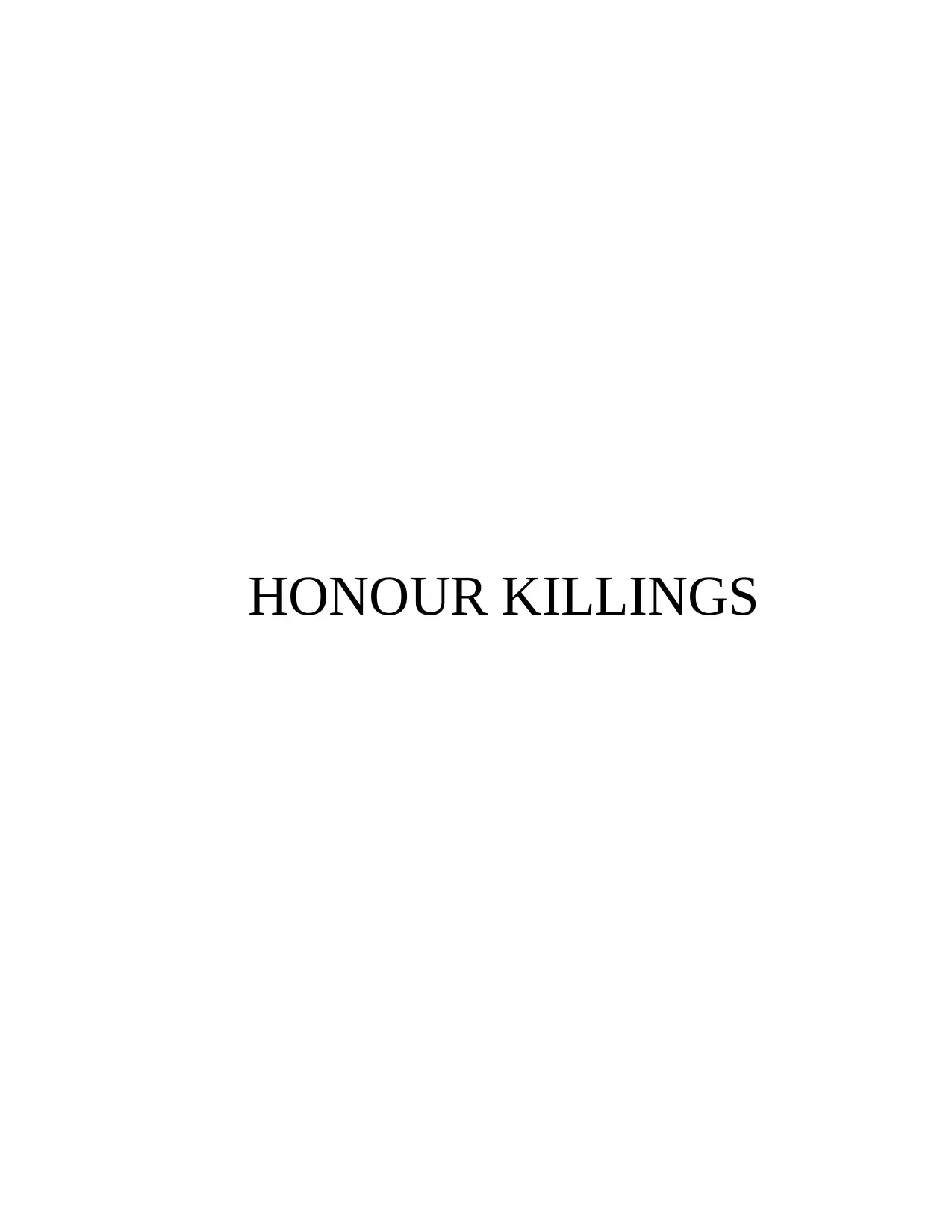
HONOUR KILLINGS
Secure Best Marks with AI Grader
Need help grading? Try our AI Grader for instant feedback on your assignments.

Acknowledgement
First of all, I would like to thank my teacher _____ for giving me this opportunity to
conduct a research on such an interesting topic. It helped me in enhancing my existing
knowledge on stated subject matter. I extend my sincere gratitude to or head of the department to
always guiding us on the path of success.
I would like to extend my sincere thanks to my parents who always directly or indirectly
helps me in every research project I prepare. In the end, I would like to thank my friends and
seniors for helping me out in making this project a successful one.
First of all, I would like to thank my teacher _____ for giving me this opportunity to
conduct a research on such an interesting topic. It helped me in enhancing my existing
knowledge on stated subject matter. I extend my sincere gratitude to or head of the department to
always guiding us on the path of success.
I would like to extend my sincere thanks to my parents who always directly or indirectly
helps me in every research project I prepare. In the end, I would like to thank my friends and
seniors for helping me out in making this project a successful one.
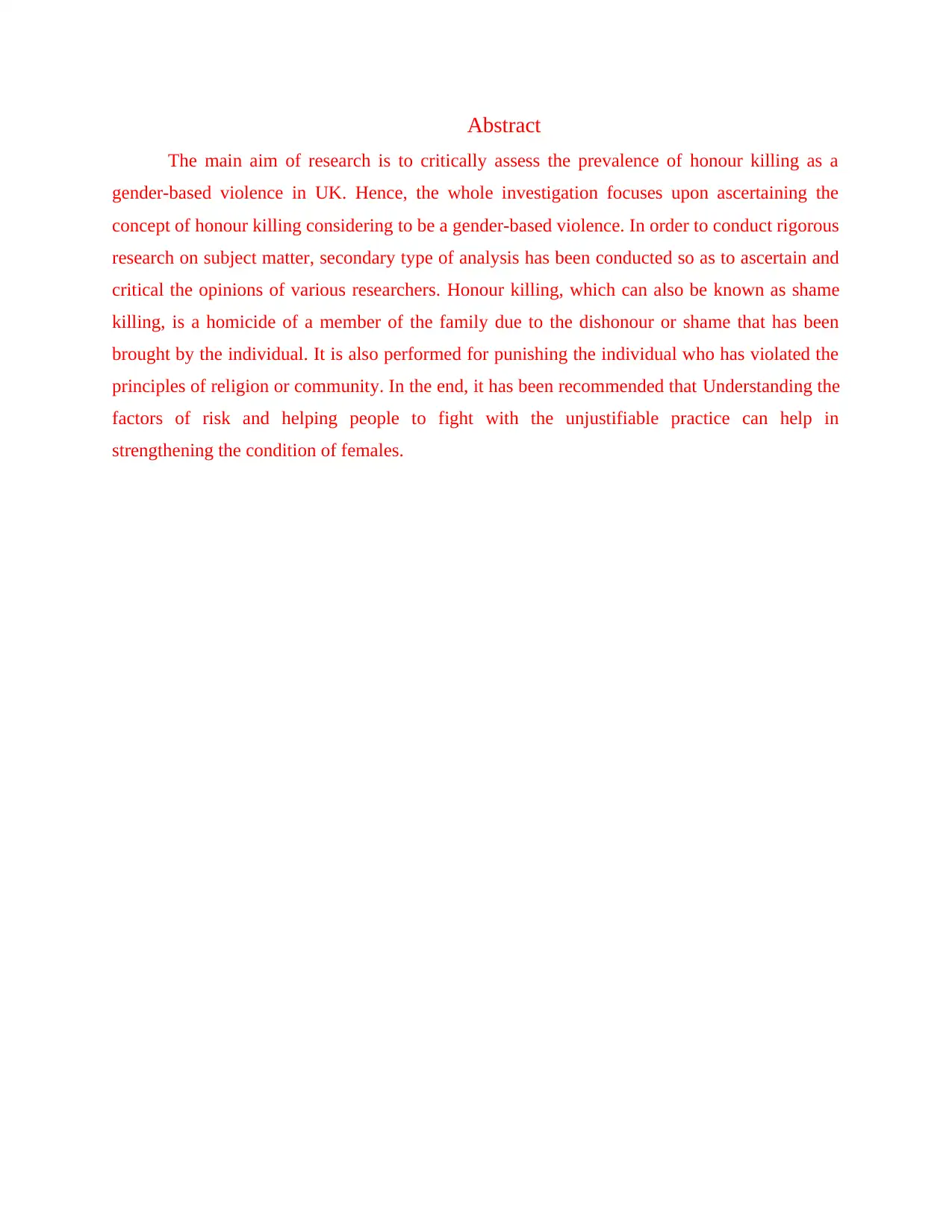
Abstract
The main aim of research is to critically assess the prevalence of honour killing as a
gender-based violence in UK. Hence, the whole investigation focuses upon ascertaining the
concept of honour killing considering to be a gender-based violence. In order to conduct rigorous
research on subject matter, secondary type of analysis has been conducted so as to ascertain and
critical the opinions of various researchers. Honour killing, which can also be known as shame
killing, is a homicide of a member of the family due to the dishonour or shame that has been
brought by the individual. It is also performed for punishing the individual who has violated the
principles of religion or community. In the end, it has been recommended that Understanding the
factors of risk and helping people to fight with the unjustifiable practice can help in
strengthening the condition of females.
The main aim of research is to critically assess the prevalence of honour killing as a
gender-based violence in UK. Hence, the whole investigation focuses upon ascertaining the
concept of honour killing considering to be a gender-based violence. In order to conduct rigorous
research on subject matter, secondary type of analysis has been conducted so as to ascertain and
critical the opinions of various researchers. Honour killing, which can also be known as shame
killing, is a homicide of a member of the family due to the dishonour or shame that has been
brought by the individual. It is also performed for punishing the individual who has violated the
principles of religion or community. In the end, it has been recommended that Understanding the
factors of risk and helping people to fight with the unjustifiable practice can help in
strengthening the condition of females.
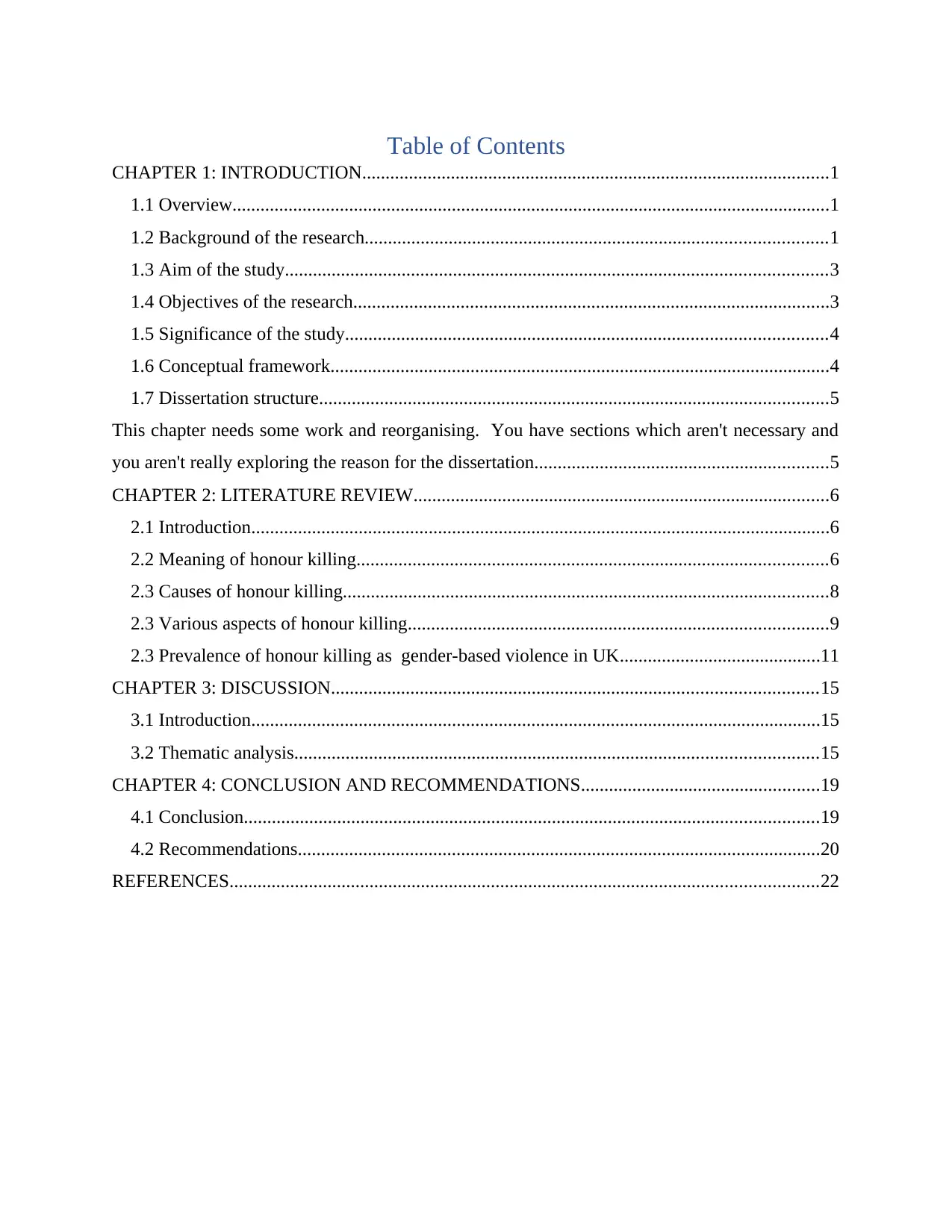
Table of Contents
CHAPTER 1: INTRODUCTION....................................................................................................1
1.1 Overview................................................................................................................................1
1.2 Background of the research...................................................................................................1
1.3 Aim of the study....................................................................................................................3
1.4 Objectives of the research......................................................................................................3
1.5 Significance of the study.......................................................................................................4
1.6 Conceptual framework...........................................................................................................4
1.7 Dissertation structure.............................................................................................................5
This chapter needs some work and reorganising. You have sections which aren't necessary and
you aren't really exploring the reason for the dissertation...............................................................5
CHAPTER 2: LITERATURE REVIEW.........................................................................................6
2.1 Introduction............................................................................................................................6
2.2 Meaning of honour killing.....................................................................................................6
2.3 Causes of honour killing........................................................................................................8
2.3 Various aspects of honour killing..........................................................................................9
2.3 Prevalence of honour killing as gender-based violence in UK...........................................11
CHAPTER 3: DISCUSSION........................................................................................................15
3.1 Introduction..........................................................................................................................15
3.2 Thematic analysis................................................................................................................15
CHAPTER 4: CONCLUSION AND RECOMMENDATIONS...................................................19
4.1 Conclusion...........................................................................................................................19
4.2 Recommendations................................................................................................................20
REFERENCES..............................................................................................................................22
CHAPTER 1: INTRODUCTION....................................................................................................1
1.1 Overview................................................................................................................................1
1.2 Background of the research...................................................................................................1
1.3 Aim of the study....................................................................................................................3
1.4 Objectives of the research......................................................................................................3
1.5 Significance of the study.......................................................................................................4
1.6 Conceptual framework...........................................................................................................4
1.7 Dissertation structure.............................................................................................................5
This chapter needs some work and reorganising. You have sections which aren't necessary and
you aren't really exploring the reason for the dissertation...............................................................5
CHAPTER 2: LITERATURE REVIEW.........................................................................................6
2.1 Introduction............................................................................................................................6
2.2 Meaning of honour killing.....................................................................................................6
2.3 Causes of honour killing........................................................................................................8
2.3 Various aspects of honour killing..........................................................................................9
2.3 Prevalence of honour killing as gender-based violence in UK...........................................11
CHAPTER 3: DISCUSSION........................................................................................................15
3.1 Introduction..........................................................................................................................15
3.2 Thematic analysis................................................................................................................15
CHAPTER 4: CONCLUSION AND RECOMMENDATIONS...................................................19
4.1 Conclusion...........................................................................................................................19
4.2 Recommendations................................................................................................................20
REFERENCES..............................................................................................................................22
Paraphrase This Document
Need a fresh take? Get an instant paraphrase of this document with our AI Paraphraser

Table of Figures
Figure 1: Honour Killings per 100 persons.....................................................................................2
Figure 2 Causes of gender inequality............................................................................................15
Figure 1: Honour Killings per 100 persons.....................................................................................2
Figure 2 Causes of gender inequality............................................................................................15
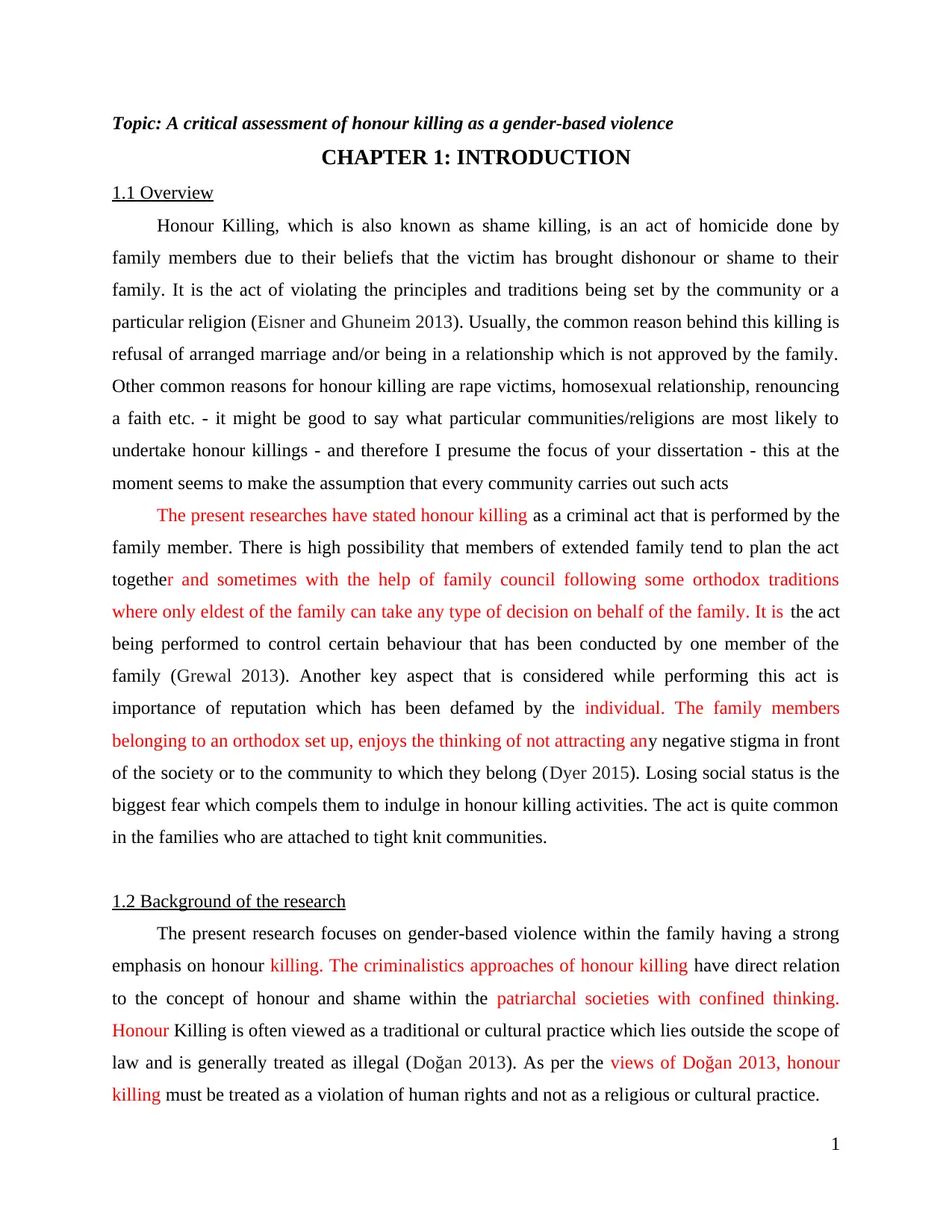
Topic: A critical assessment of honour killing as a gender-based violence
CHAPTER 1: INTRODUCTION
1.1 Overview
Honour Killing, which is also known as shame killing, is an act of homicide done by
family members due to their beliefs that the victim has brought dishonour or shame to their
family. It is the act of violating the principles and traditions being set by the community or a
particular religion (Eisner and Ghuneim 2013). Usually, the common reason behind this killing is
refusal of arranged marriage and/or being in a relationship which is not approved by the family.
Other common reasons for honour killing are rape victims, homosexual relationship, renouncing
a faith etc. - it might be good to say what particular communities/religions are most likely to
undertake honour killings - and therefore I presume the focus of your dissertation - this at the
moment seems to make the assumption that every community carries out such acts
The present researches have stated honour killing as a criminal act that is performed by the
family member. There is high possibility that members of extended family tend to plan the act
together and sometimes with the help of family council following some orthodox traditions
where only eldest of the family can take any type of decision on behalf of the family. It is the act
being performed to control certain behaviour that has been conducted by one member of the
family (Grewal 2013). Another key aspect that is considered while performing this act is
importance of reputation which has been defamed by the individual. The family members
belonging to an orthodox set up, enjoys the thinking of not attracting any negative stigma in front
of the society or to the community to which they belong (Dyer 2015). Losing social status is the
biggest fear which compels them to indulge in honour killing activities. The act is quite common
in the families who are attached to tight knit communities.
1.2 Background of the research
The present research focuses on gender-based violence within the family having a strong
emphasis on honour killing. The criminalistics approaches of honour killing have direct relation
to the concept of honour and shame within the patriarchal societies with confined thinking.
Honour Killing is often viewed as a traditional or cultural practice which lies outside the scope of
law and is generally treated as illegal (Doğan 2013). As per the views of Doğan 2013, honour
killing must be treated as a violation of human rights and not as a religious or cultural practice.
1
CHAPTER 1: INTRODUCTION
1.1 Overview
Honour Killing, which is also known as shame killing, is an act of homicide done by
family members due to their beliefs that the victim has brought dishonour or shame to their
family. It is the act of violating the principles and traditions being set by the community or a
particular religion (Eisner and Ghuneim 2013). Usually, the common reason behind this killing is
refusal of arranged marriage and/or being in a relationship which is not approved by the family.
Other common reasons for honour killing are rape victims, homosexual relationship, renouncing
a faith etc. - it might be good to say what particular communities/religions are most likely to
undertake honour killings - and therefore I presume the focus of your dissertation - this at the
moment seems to make the assumption that every community carries out such acts
The present researches have stated honour killing as a criminal act that is performed by the
family member. There is high possibility that members of extended family tend to plan the act
together and sometimes with the help of family council following some orthodox traditions
where only eldest of the family can take any type of decision on behalf of the family. It is the act
being performed to control certain behaviour that has been conducted by one member of the
family (Grewal 2013). Another key aspect that is considered while performing this act is
importance of reputation which has been defamed by the individual. The family members
belonging to an orthodox set up, enjoys the thinking of not attracting any negative stigma in front
of the society or to the community to which they belong (Dyer 2015). Losing social status is the
biggest fear which compels them to indulge in honour killing activities. The act is quite common
in the families who are attached to tight knit communities.
1.2 Background of the research
The present research focuses on gender-based violence within the family having a strong
emphasis on honour killing. The criminalistics approaches of honour killing have direct relation
to the concept of honour and shame within the patriarchal societies with confined thinking.
Honour Killing is often viewed as a traditional or cultural practice which lies outside the scope of
law and is generally treated as illegal (Doğan 2013). As per the views of Doğan 2013, honour
killing must be treated as a violation of human rights and not as a religious or cultural practice.
1
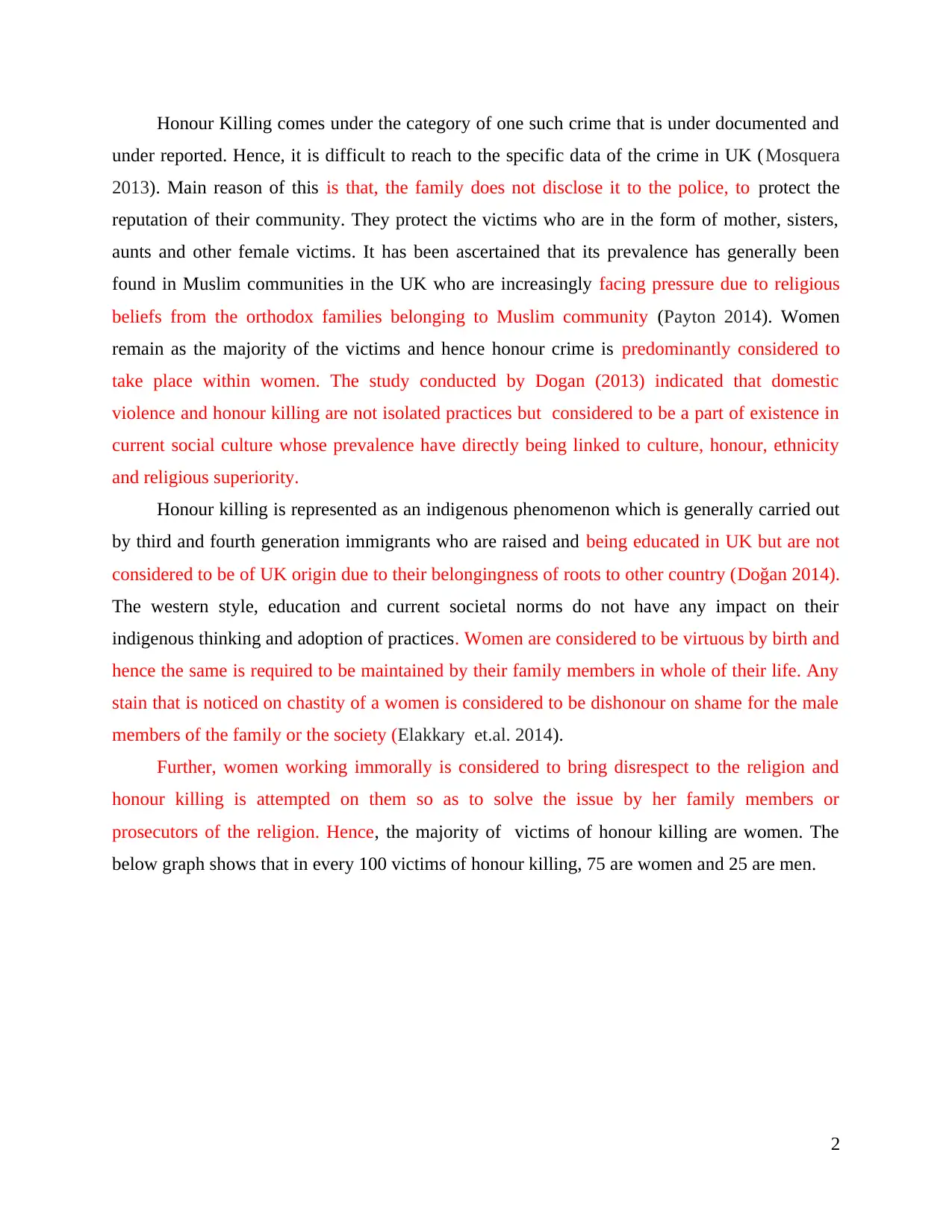
Honour Killing comes under the category of one such crime that is under documented and
under reported. Hence, it is difficult to reach to the specific data of the crime in UK (Mosquera
2013). Main reason of this is that, the family does not disclose it to the police, to protect the
reputation of their community. They protect the victims who are in the form of mother, sisters,
aunts and other female victims. It has been ascertained that its prevalence has generally been
found in Muslim communities in the UK who are increasingly facing pressure due to religious
beliefs from the orthodox families belonging to Muslim community (Payton 2014). Women
remain as the majority of the victims and hence honour crime is predominantly considered to
take place within women. The study conducted by Dogan (2013) indicated that domestic
violence and honour killing are not isolated practices but considered to be a part of existence in
current social culture whose prevalence have directly being linked to culture, honour, ethnicity
and religious superiority.
Honour killing is represented as an indigenous phenomenon which is generally carried out
by third and fourth generation immigrants who are raised and being educated in UK but are not
considered to be of UK origin due to their belongingness of roots to other country (Doğan 2014).
The western style, education and current societal norms do not have any impact on their
indigenous thinking and adoption of practices. Women are considered to be virtuous by birth and
hence the same is required to be maintained by their family members in whole of their life. Any
stain that is noticed on chastity of a women is considered to be dishonour on shame for the male
members of the family or the society (Elakkary et.al. 2014).
Further, women working immorally is considered to bring disrespect to the religion and
honour killing is attempted on them so as to solve the issue by her family members or
prosecutors of the religion. Hence, the majority of victims of honour killing are women. The
below graph shows that in every 100 victims of honour killing, 75 are women and 25 are men.
2
under reported. Hence, it is difficult to reach to the specific data of the crime in UK (Mosquera
2013). Main reason of this is that, the family does not disclose it to the police, to protect the
reputation of their community. They protect the victims who are in the form of mother, sisters,
aunts and other female victims. It has been ascertained that its prevalence has generally been
found in Muslim communities in the UK who are increasingly facing pressure due to religious
beliefs from the orthodox families belonging to Muslim community (Payton 2014). Women
remain as the majority of the victims and hence honour crime is predominantly considered to
take place within women. The study conducted by Dogan (2013) indicated that domestic
violence and honour killing are not isolated practices but considered to be a part of existence in
current social culture whose prevalence have directly being linked to culture, honour, ethnicity
and religious superiority.
Honour killing is represented as an indigenous phenomenon which is generally carried out
by third and fourth generation immigrants who are raised and being educated in UK but are not
considered to be of UK origin due to their belongingness of roots to other country (Doğan 2014).
The western style, education and current societal norms do not have any impact on their
indigenous thinking and adoption of practices. Women are considered to be virtuous by birth and
hence the same is required to be maintained by their family members in whole of their life. Any
stain that is noticed on chastity of a women is considered to be dishonour on shame for the male
members of the family or the society (Elakkary et.al. 2014).
Further, women working immorally is considered to bring disrespect to the religion and
honour killing is attempted on them so as to solve the issue by her family members or
prosecutors of the religion. Hence, the majority of victims of honour killing are women. The
below graph shows that in every 100 victims of honour killing, 75 are women and 25 are men.
2
Secure Best Marks with AI Grader
Need help grading? Try our AI Grader for instant feedback on your assignments.
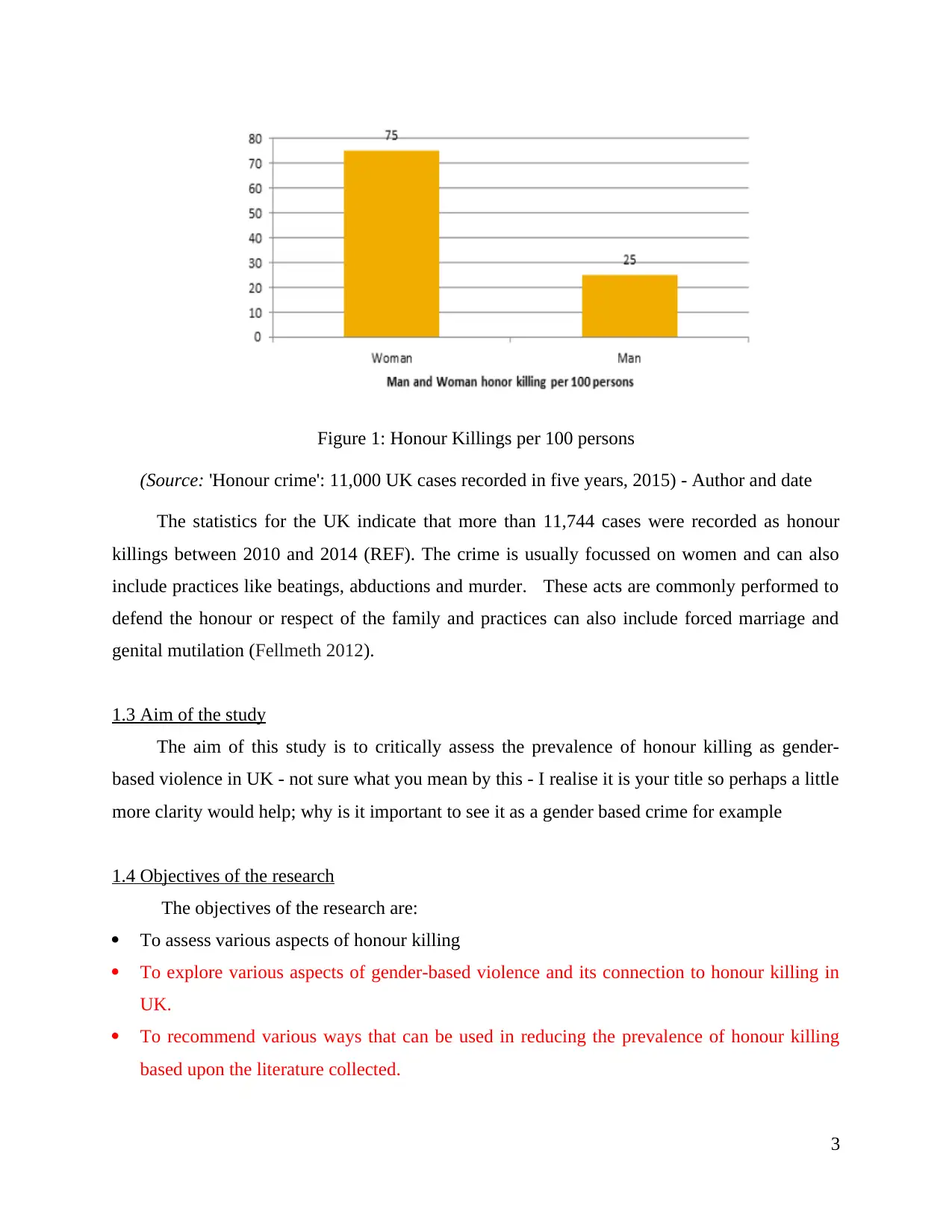
Figure 1: Honour Killings per 100 persons
(Source: 'Honour crime': 11,000 UK cases recorded in five years, 2015) - Author and date
The statistics for the UK indicate that more than 11,744 cases were recorded as honour
killings between 2010 and 2014 (REF). The crime is usually focussed on women and can also
include practices like beatings, abductions and murder. These acts are commonly performed to
defend the honour or respect of the family and practices can also include forced marriage and
genital mutilation (Fellmeth 2012).
1.3 Aim of the study
The aim of this study is to critically assess the prevalence of honour killing as gender-
based violence in UK - not sure what you mean by this - I realise it is your title so perhaps a little
more clarity would help; why is it important to see it as a gender based crime for example
1.4 Objectives of the research
The objectives of the research are:
To assess various aspects of honour killing
To explore various aspects of gender-based violence and its connection to honour killing in
UK.
To recommend various ways that can be used in reducing the prevalence of honour killing
based upon the literature collected.
3
(Source: 'Honour crime': 11,000 UK cases recorded in five years, 2015) - Author and date
The statistics for the UK indicate that more than 11,744 cases were recorded as honour
killings between 2010 and 2014 (REF). The crime is usually focussed on women and can also
include practices like beatings, abductions and murder. These acts are commonly performed to
defend the honour or respect of the family and practices can also include forced marriage and
genital mutilation (Fellmeth 2012).
1.3 Aim of the study
The aim of this study is to critically assess the prevalence of honour killing as gender-
based violence in UK - not sure what you mean by this - I realise it is your title so perhaps a little
more clarity would help; why is it important to see it as a gender based crime for example
1.4 Objectives of the research
The objectives of the research are:
To assess various aspects of honour killing
To explore various aspects of gender-based violence and its connection to honour killing in
UK.
To recommend various ways that can be used in reducing the prevalence of honour killing
based upon the literature collected.
3

1.5 Significance of the study
The present research on the topic of honour killing will help in devising adequate amount
of knowledge regarding the subject matter. It will also be helpful in analysing various case
studies and incidents that could have taken place in various parts of the world. - to do what? it is
not clear how this is the 'significance of your study' and you could actually remove it as it isn't
really needed. Your word count would be better used in the Introduction exploring and
discussing the communities in the research and some of the cultural reasons that honour killing
may occur
1.6 Conceptual framework
Conceptual framework helps in giving a brief knowledge regarding the research
methodology that will be followed by the researcher in conducting the research. Hence, the
following research methodology will be used in the present research of honour killing: Research design: Case study approach will be used by the researcher to conduct the
research. Various cases will be analysed to reach to effective results in a particular opinion
for the present study of honour killing (Chesler, 2015). Research philosophy: Interpretivism research philosophy will be used so as to understand
the theoretical aspects of honour killing. Research type: Qualitative research type will be used by the scholar which will help in
deriving concrete knowledge regarding the subject matter. It will help in reaching to an
effective analysis and thereby appropriate results. Qualitative research is usually adopted to
gain adequate understanding regarding motivations, reasons and opinions so as to build
understating regarding subject matter. Research approach: Since, existing theories will be analysed in the present research. Hence,
deductive approach will be used by the researcher to conduct the study. Deductive approach
is concerned with development of hypothesis based upon the existing theories and design the
research strategy based upon it. Data collection: Secondary type of data will be used to collect the data regarding honour
killing. It will be collected through books, journals and online format (Gill, 2013). Data analysis: Critical analysis of the opinion of the researcher will help in deriving the
results for the study. Further, thematic technique will be used where themes will be
formulated to analyse the collected data.
4
The present research on the topic of honour killing will help in devising adequate amount
of knowledge regarding the subject matter. It will also be helpful in analysing various case
studies and incidents that could have taken place in various parts of the world. - to do what? it is
not clear how this is the 'significance of your study' and you could actually remove it as it isn't
really needed. Your word count would be better used in the Introduction exploring and
discussing the communities in the research and some of the cultural reasons that honour killing
may occur
1.6 Conceptual framework
Conceptual framework helps in giving a brief knowledge regarding the research
methodology that will be followed by the researcher in conducting the research. Hence, the
following research methodology will be used in the present research of honour killing: Research design: Case study approach will be used by the researcher to conduct the
research. Various cases will be analysed to reach to effective results in a particular opinion
for the present study of honour killing (Chesler, 2015). Research philosophy: Interpretivism research philosophy will be used so as to understand
the theoretical aspects of honour killing. Research type: Qualitative research type will be used by the scholar which will help in
deriving concrete knowledge regarding the subject matter. It will help in reaching to an
effective analysis and thereby appropriate results. Qualitative research is usually adopted to
gain adequate understanding regarding motivations, reasons and opinions so as to build
understating regarding subject matter. Research approach: Since, existing theories will be analysed in the present research. Hence,
deductive approach will be used by the researcher to conduct the study. Deductive approach
is concerned with development of hypothesis based upon the existing theories and design the
research strategy based upon it. Data collection: Secondary type of data will be used to collect the data regarding honour
killing. It will be collected through books, journals and online format (Gill, 2013). Data analysis: Critical analysis of the opinion of the researcher will help in deriving the
results for the study. Further, thematic technique will be used where themes will be
formulated to analyse the collected data.
4
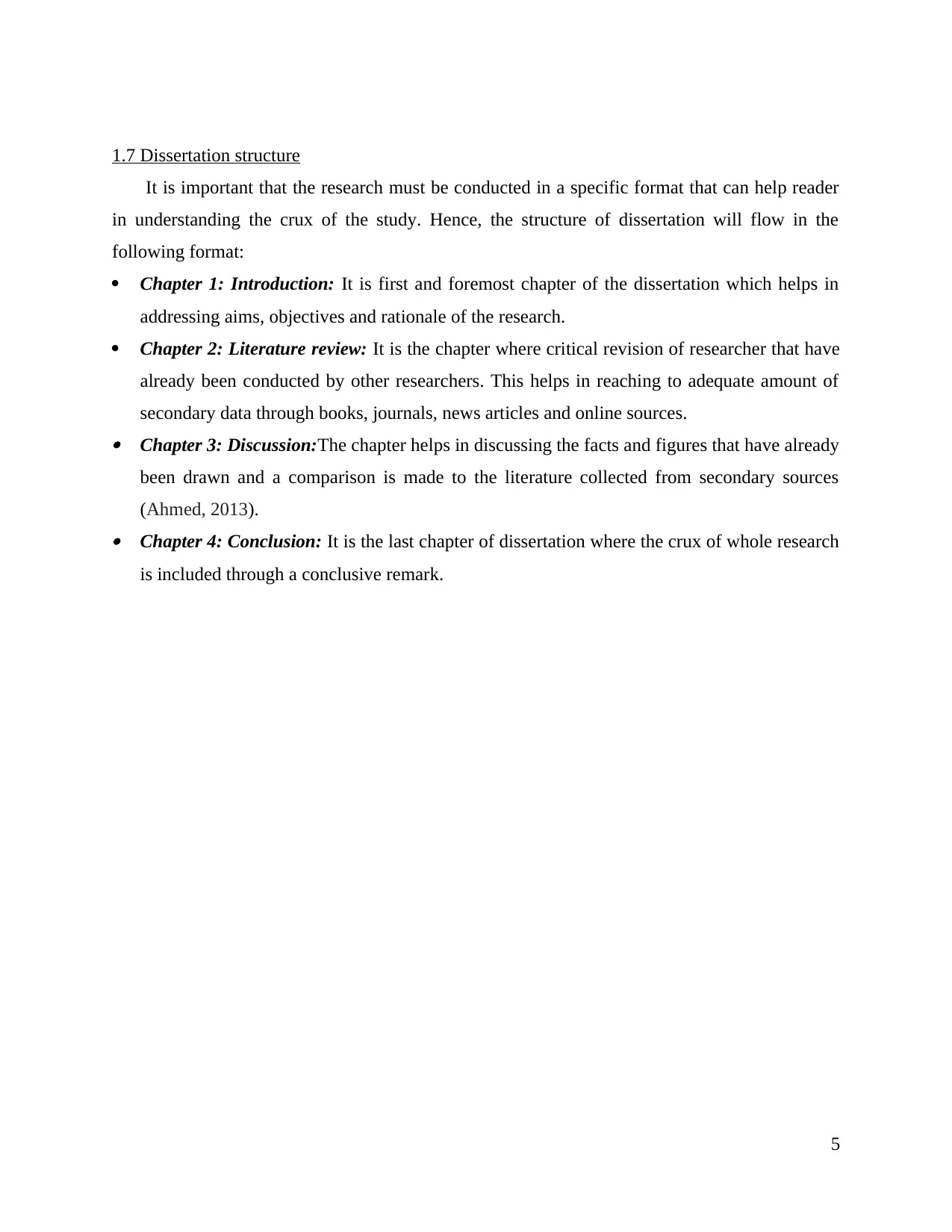
1.7 Dissertation structure
It is important that the research must be conducted in a specific format that can help reader
in understanding the crux of the study. Hence, the structure of dissertation will flow in the
following format:
Chapter 1: Introduction: It is first and foremost chapter of the dissertation which helps in
addressing aims, objectives and rationale of the research.
Chapter 2: Literature review: It is the chapter where critical revision of researcher that have
already been conducted by other researchers. This helps in reaching to adequate amount of
secondary data through books, journals, news articles and online sources. Chapter 3: Discussion:The chapter helps in discussing the facts and figures that have already
been drawn and a comparison is made to the literature collected from secondary sources
(Ahmed, 2013). Chapter 4: Conclusion: It is the last chapter of dissertation where the crux of whole research
is included through a conclusive remark.
5
It is important that the research must be conducted in a specific format that can help reader
in understanding the crux of the study. Hence, the structure of dissertation will flow in the
following format:
Chapter 1: Introduction: It is first and foremost chapter of the dissertation which helps in
addressing aims, objectives and rationale of the research.
Chapter 2: Literature review: It is the chapter where critical revision of researcher that have
already been conducted by other researchers. This helps in reaching to adequate amount of
secondary data through books, journals, news articles and online sources. Chapter 3: Discussion:The chapter helps in discussing the facts and figures that have already
been drawn and a comparison is made to the literature collected from secondary sources
(Ahmed, 2013). Chapter 4: Conclusion: It is the last chapter of dissertation where the crux of whole research
is included through a conclusive remark.
5
Paraphrase This Document
Need a fresh take? Get an instant paraphrase of this document with our AI Paraphraser
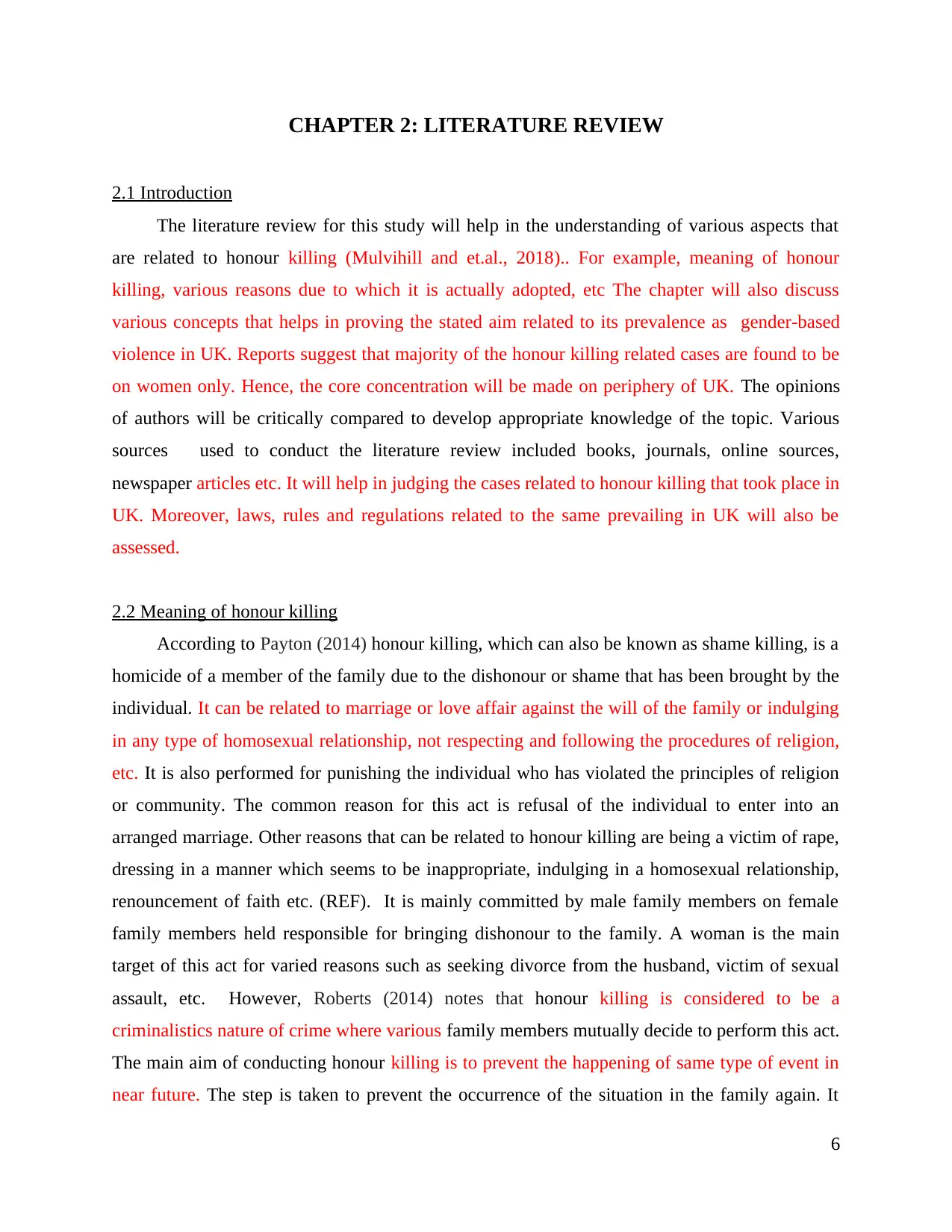
CHAPTER 2: LITERATURE REVIEW
2.1 Introduction
The literature review for this study will help in the understanding of various aspects that
are related to honour killing (Mulvihill and et.al., 2018).. For example, meaning of honour
killing, various reasons due to which it is actually adopted, etc The chapter will also discuss
various concepts that helps in proving the stated aim related to its prevalence as gender-based
violence in UK. Reports suggest that majority of the honour killing related cases are found to be
on women only. Hence, the core concentration will be made on periphery of UK. The opinions
of authors will be critically compared to develop appropriate knowledge of the topic. Various
sources used to conduct the literature review included books, journals, online sources,
newspaper articles etc. It will help in judging the cases related to honour killing that took place in
UK. Moreover, laws, rules and regulations related to the same prevailing in UK will also be
assessed.
2.2 Meaning of honour killing
According to Payton (2014) honour killing, which can also be known as shame killing, is a
homicide of a member of the family due to the dishonour or shame that has been brought by the
individual. It can be related to marriage or love affair against the will of the family or indulging
in any type of homosexual relationship, not respecting and following the procedures of religion,
etc. It is also performed for punishing the individual who has violated the principles of religion
or community. The common reason for this act is refusal of the individual to enter into an
arranged marriage. Other reasons that can be related to honour killing are being a victim of rape,
dressing in a manner which seems to be inappropriate, indulging in a homosexual relationship,
renouncement of faith etc. (REF). It is mainly committed by male family members on female
family members held responsible for bringing dishonour to the family. A woman is the main
target of this act for varied reasons such as seeking divorce from the husband, victim of sexual
assault, etc. However, Roberts (2014) notes that honour killing is considered to be a
criminalistics nature of crime where various family members mutually decide to perform this act.
The main aim of conducting honour killing is to prevent the happening of same type of event in
near future. The step is taken to prevent the occurrence of the situation in the family again. It
6
2.1 Introduction
The literature review for this study will help in the understanding of various aspects that
are related to honour killing (Mulvihill and et.al., 2018).. For example, meaning of honour
killing, various reasons due to which it is actually adopted, etc The chapter will also discuss
various concepts that helps in proving the stated aim related to its prevalence as gender-based
violence in UK. Reports suggest that majority of the honour killing related cases are found to be
on women only. Hence, the core concentration will be made on periphery of UK. The opinions
of authors will be critically compared to develop appropriate knowledge of the topic. Various
sources used to conduct the literature review included books, journals, online sources,
newspaper articles etc. It will help in judging the cases related to honour killing that took place in
UK. Moreover, laws, rules and regulations related to the same prevailing in UK will also be
assessed.
2.2 Meaning of honour killing
According to Payton (2014) honour killing, which can also be known as shame killing, is a
homicide of a member of the family due to the dishonour or shame that has been brought by the
individual. It can be related to marriage or love affair against the will of the family or indulging
in any type of homosexual relationship, not respecting and following the procedures of religion,
etc. It is also performed for punishing the individual who has violated the principles of religion
or community. The common reason for this act is refusal of the individual to enter into an
arranged marriage. Other reasons that can be related to honour killing are being a victim of rape,
dressing in a manner which seems to be inappropriate, indulging in a homosexual relationship,
renouncement of faith etc. (REF). It is mainly committed by male family members on female
family members held responsible for bringing dishonour to the family. A woman is the main
target of this act for varied reasons such as seeking divorce from the husband, victim of sexual
assault, etc. However, Roberts (2014) notes that honour killing is considered to be a
criminalistics nature of crime where various family members mutually decide to perform this act.
The main aim of conducting honour killing is to prevent the happening of same type of event in
near future. The step is taken to prevent the occurrence of the situation in the family again. It
6
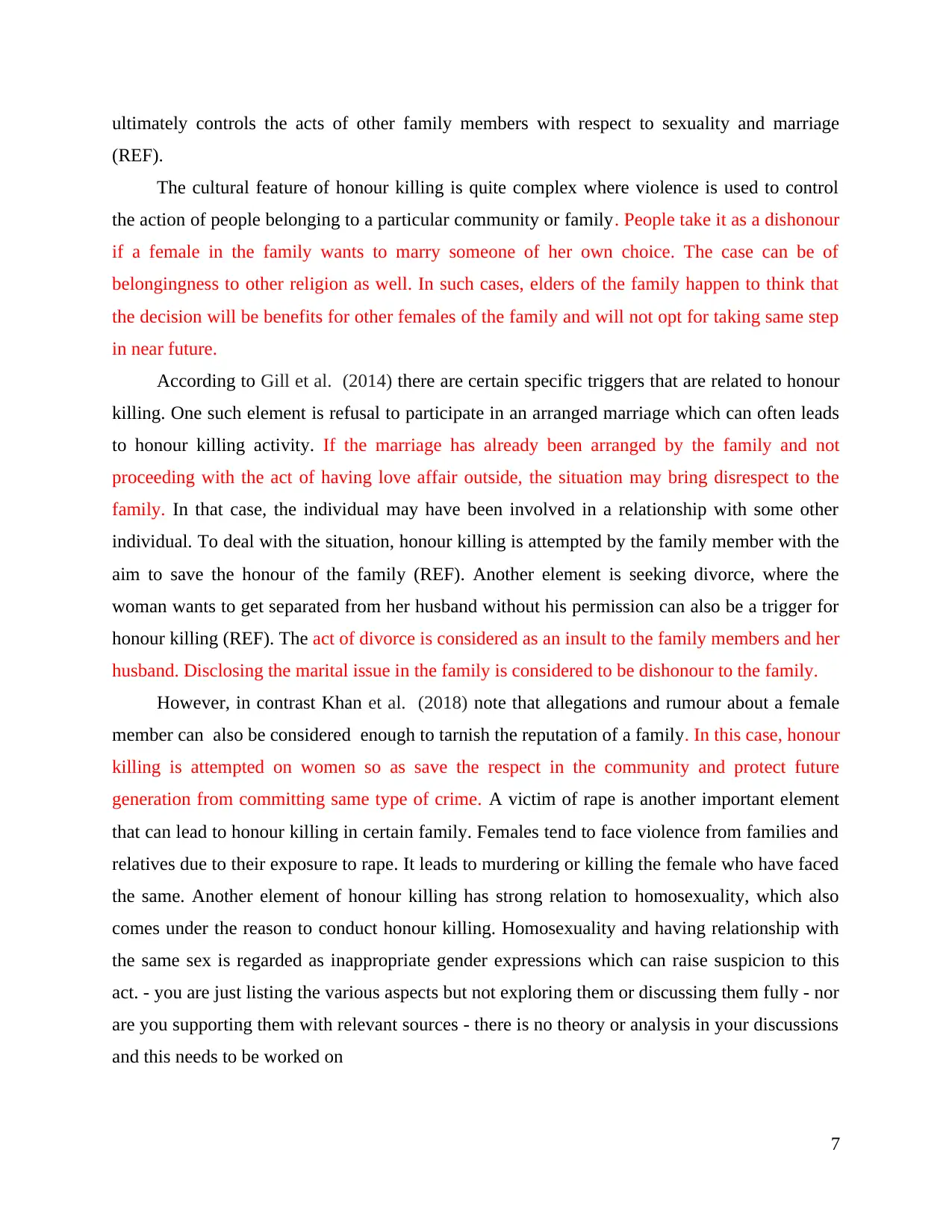
ultimately controls the acts of other family members with respect to sexuality and marriage
(REF).
The cultural feature of honour killing is quite complex where violence is used to control
the action of people belonging to a particular community or family. People take it as a dishonour
if a female in the family wants to marry someone of her own choice. The case can be of
belongingness to other religion as well. In such cases, elders of the family happen to think that
the decision will be benefits for other females of the family and will not opt for taking same step
in near future.
According to Gill et al. (2014) there are certain specific triggers that are related to honour
killing. One such element is refusal to participate in an arranged marriage which can often leads
to honour killing activity. If the marriage has already been arranged by the family and not
proceeding with the act of having love affair outside, the situation may bring disrespect to the
family. In that case, the individual may have been involved in a relationship with some other
individual. To deal with the situation, honour killing is attempted by the family member with the
aim to save the honour of the family (REF). Another element is seeking divorce, where the
woman wants to get separated from her husband without his permission can also be a trigger for
honour killing (REF). The act of divorce is considered as an insult to the family members and her
husband. Disclosing the marital issue in the family is considered to be dishonour to the family.
However, in contrast Khan et al. (2018) note that allegations and rumour about a female
member can also be considered enough to tarnish the reputation of a family. In this case, honour
killing is attempted on women so as save the respect in the community and protect future
generation from committing same type of crime. A victim of rape is another important element
that can lead to honour killing in certain family. Females tend to face violence from families and
relatives due to their exposure to rape. It leads to murdering or killing the female who have faced
the same. Another element of honour killing has strong relation to homosexuality, which also
comes under the reason to conduct honour killing. Homosexuality and having relationship with
the same sex is regarded as inappropriate gender expressions which can raise suspicion to this
act. - you are just listing the various aspects but not exploring them or discussing them fully - nor
are you supporting them with relevant sources - there is no theory or analysis in your discussions
and this needs to be worked on
7
(REF).
The cultural feature of honour killing is quite complex where violence is used to control
the action of people belonging to a particular community or family. People take it as a dishonour
if a female in the family wants to marry someone of her own choice. The case can be of
belongingness to other religion as well. In such cases, elders of the family happen to think that
the decision will be benefits for other females of the family and will not opt for taking same step
in near future.
According to Gill et al. (2014) there are certain specific triggers that are related to honour
killing. One such element is refusal to participate in an arranged marriage which can often leads
to honour killing activity. If the marriage has already been arranged by the family and not
proceeding with the act of having love affair outside, the situation may bring disrespect to the
family. In that case, the individual may have been involved in a relationship with some other
individual. To deal with the situation, honour killing is attempted by the family member with the
aim to save the honour of the family (REF). Another element is seeking divorce, where the
woman wants to get separated from her husband without his permission can also be a trigger for
honour killing (REF). The act of divorce is considered as an insult to the family members and her
husband. Disclosing the marital issue in the family is considered to be dishonour to the family.
However, in contrast Khan et al. (2018) note that allegations and rumour about a female
member can also be considered enough to tarnish the reputation of a family. In this case, honour
killing is attempted on women so as save the respect in the community and protect future
generation from committing same type of crime. A victim of rape is another important element
that can lead to honour killing in certain family. Females tend to face violence from families and
relatives due to their exposure to rape. It leads to murdering or killing the female who have faced
the same. Another element of honour killing has strong relation to homosexuality, which also
comes under the reason to conduct honour killing. Homosexuality and having relationship with
the same sex is regarded as inappropriate gender expressions which can raise suspicion to this
act. - you are just listing the various aspects but not exploring them or discussing them fully - nor
are you supporting them with relevant sources - there is no theory or analysis in your discussions
and this needs to be worked on
7

According to Caffaro et al. (2016) in patriarchal societies, the activities being performed
by girls and women are closely monitored. It is the responsibility of male members of the family
to protect women’s virginity and sexual purity. The victims of honour killing are engaged in
sexually immoral actions and the perception of family members and the community are related to
killing of the females. However, in comparison Khan (2018) suggests these types of crimes are
widely unreported. As per the estimation of United Nations Population Fund (REF), 5000
women are killed annually as a victim of honour. The act is common in various countries of
Middle East, South Asia, India and Pakistan. The act has come under the periphery of illegal
performances in the countries and the court of law have adequate legislatives to prosecute the
individual for killing. The individual can adequately be punished on the grounds of illegal acts of
performing honour killing.
2.3 Causes of honour killing
According to García-Moreno et.al. (2015), honour killing is considered as a curse to the
society. As per the views of García-Moreno et.al. (2015) it is a result of strong patriarchal views
of the society. The women are considered to be dependent on their fathers and husband in the
male dominant society. They are required to obey their decision and hence are not allowed to
make their own decisions. Women are viewed as property who do not have right to take their
own decisions. Failure to perform the act of being dependent on male members of the family, can
lead to violent punishment and thereby honour killing as well. Male family members only have
the right to decide their fate. Women are demanded to preserve their virginity till marriage.
Hence, a woman cannot be involved in premarital sex adultery as it is not considered to be an act
acceptable by the family. These traditional thinking and patriarchal nature of rules and
regulations tend to stop the woman from deciding their steps (REF). However, not following the
rules and regulations commonly results in honour killing activities. However, in contrast
Gill(2014) proposes that the concept of honour of the family is considered to be extremely
important in certain families. Certain acts that are performed by the family members are not
considered appropriate and hence, measured to come under the periphery of punishment. The act
is inappropriate by the law but majority of the cases are left unreported. Hence, the statistics on
honour killing are not correctly represented by the various countries. Inappropriate dressing is
also not allowed by the family members which also leads to defaming people. It is assessed that
8
by girls and women are closely monitored. It is the responsibility of male members of the family
to protect women’s virginity and sexual purity. The victims of honour killing are engaged in
sexually immoral actions and the perception of family members and the community are related to
killing of the females. However, in comparison Khan (2018) suggests these types of crimes are
widely unreported. As per the estimation of United Nations Population Fund (REF), 5000
women are killed annually as a victim of honour. The act is common in various countries of
Middle East, South Asia, India and Pakistan. The act has come under the periphery of illegal
performances in the countries and the court of law have adequate legislatives to prosecute the
individual for killing. The individual can adequately be punished on the grounds of illegal acts of
performing honour killing.
2.3 Causes of honour killing
According to García-Moreno et.al. (2015), honour killing is considered as a curse to the
society. As per the views of García-Moreno et.al. (2015) it is a result of strong patriarchal views
of the society. The women are considered to be dependent on their fathers and husband in the
male dominant society. They are required to obey their decision and hence are not allowed to
make their own decisions. Women are viewed as property who do not have right to take their
own decisions. Failure to perform the act of being dependent on male members of the family, can
lead to violent punishment and thereby honour killing as well. Male family members only have
the right to decide their fate. Women are demanded to preserve their virginity till marriage.
Hence, a woman cannot be involved in premarital sex adultery as it is not considered to be an act
acceptable by the family. These traditional thinking and patriarchal nature of rules and
regulations tend to stop the woman from deciding their steps (REF). However, not following the
rules and regulations commonly results in honour killing activities. However, in contrast
Gill(2014) proposes that the concept of honour of the family is considered to be extremely
important in certain families. Certain acts that are performed by the family members are not
considered appropriate and hence, measured to come under the periphery of punishment. The act
is inappropriate by the law but majority of the cases are left unreported. Hence, the statistics on
honour killing are not correctly represented by the various countries. Inappropriate dressing is
also not allowed by the family members which also leads to defaming people. It is assessed that
8
Secure Best Marks with AI Grader
Need help grading? Try our AI Grader for instant feedback on your assignments.
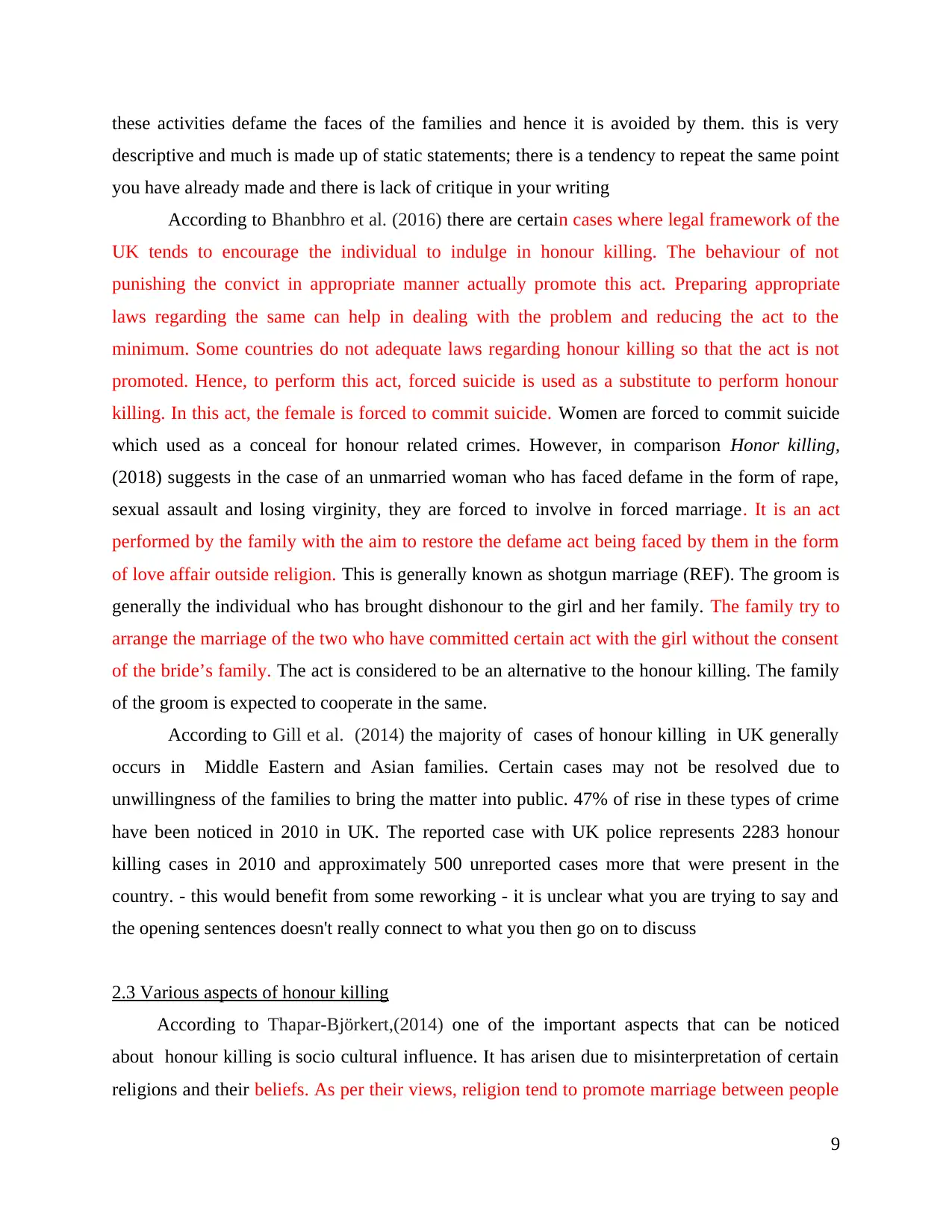
these activities defame the faces of the families and hence it is avoided by them. this is very
descriptive and much is made up of static statements; there is a tendency to repeat the same point
you have already made and there is lack of critique in your writing
According to Bhanbhro et al. (2016) there are certain cases where legal framework of the
UK tends to encourage the individual to indulge in honour killing. The behaviour of not
punishing the convict in appropriate manner actually promote this act. Preparing appropriate
laws regarding the same can help in dealing with the problem and reducing the act to the
minimum. Some countries do not adequate laws regarding honour killing so that the act is not
promoted. Hence, to perform this act, forced suicide is used as a substitute to perform honour
killing. In this act, the female is forced to commit suicide. Women are forced to commit suicide
which used as a conceal for honour related crimes. However, in comparison Honor killing,
(2018) suggests in the case of an unmarried woman who has faced defame in the form of rape,
sexual assault and losing virginity, they are forced to involve in forced marriage. It is an act
performed by the family with the aim to restore the defame act being faced by them in the form
of love affair outside religion. This is generally known as shotgun marriage (REF). The groom is
generally the individual who has brought dishonour to the girl and her family. The family try to
arrange the marriage of the two who have committed certain act with the girl without the consent
of the bride’s family. The act is considered to be an alternative to the honour killing. The family
of the groom is expected to cooperate in the same.
According to Gill et al. (2014) the majority of cases of honour killing in UK generally
occurs in Middle Eastern and Asian families. Certain cases may not be resolved due to
unwillingness of the families to bring the matter into public. 47% of rise in these types of crime
have been noticed in 2010 in UK. The reported case with UK police represents 2283 honour
killing cases in 2010 and approximately 500 unreported cases more that were present in the
country. - this would benefit from some reworking - it is unclear what you are trying to say and
the opening sentences doesn't really connect to what you then go on to discuss
2.3 Various aspects of honour killing
According to Thapar-Björkert,(2014) one of the important aspects that can be noticed
about honour killing is socio cultural influence. It has arisen due to misinterpretation of certain
religions and their beliefs. As per their views, religion tend to promote marriage between people
9
descriptive and much is made up of static statements; there is a tendency to repeat the same point
you have already made and there is lack of critique in your writing
According to Bhanbhro et al. (2016) there are certain cases where legal framework of the
UK tends to encourage the individual to indulge in honour killing. The behaviour of not
punishing the convict in appropriate manner actually promote this act. Preparing appropriate
laws regarding the same can help in dealing with the problem and reducing the act to the
minimum. Some countries do not adequate laws regarding honour killing so that the act is not
promoted. Hence, to perform this act, forced suicide is used as a substitute to perform honour
killing. In this act, the female is forced to commit suicide. Women are forced to commit suicide
which used as a conceal for honour related crimes. However, in comparison Honor killing,
(2018) suggests in the case of an unmarried woman who has faced defame in the form of rape,
sexual assault and losing virginity, they are forced to involve in forced marriage. It is an act
performed by the family with the aim to restore the defame act being faced by them in the form
of love affair outside religion. This is generally known as shotgun marriage (REF). The groom is
generally the individual who has brought dishonour to the girl and her family. The family try to
arrange the marriage of the two who have committed certain act with the girl without the consent
of the bride’s family. The act is considered to be an alternative to the honour killing. The family
of the groom is expected to cooperate in the same.
According to Gill et al. (2014) the majority of cases of honour killing in UK generally
occurs in Middle Eastern and Asian families. Certain cases may not be resolved due to
unwillingness of the families to bring the matter into public. 47% of rise in these types of crime
have been noticed in 2010 in UK. The reported case with UK police represents 2283 honour
killing cases in 2010 and approximately 500 unreported cases more that were present in the
country. - this would benefit from some reworking - it is unclear what you are trying to say and
the opening sentences doesn't really connect to what you then go on to discuss
2.3 Various aspects of honour killing
According to Thapar-Björkert,(2014) one of the important aspects that can be noticed
about honour killing is socio cultural influence. It has arisen due to misinterpretation of certain
religions and their beliefs. As per their views, religion tend to promote marriage between people
9
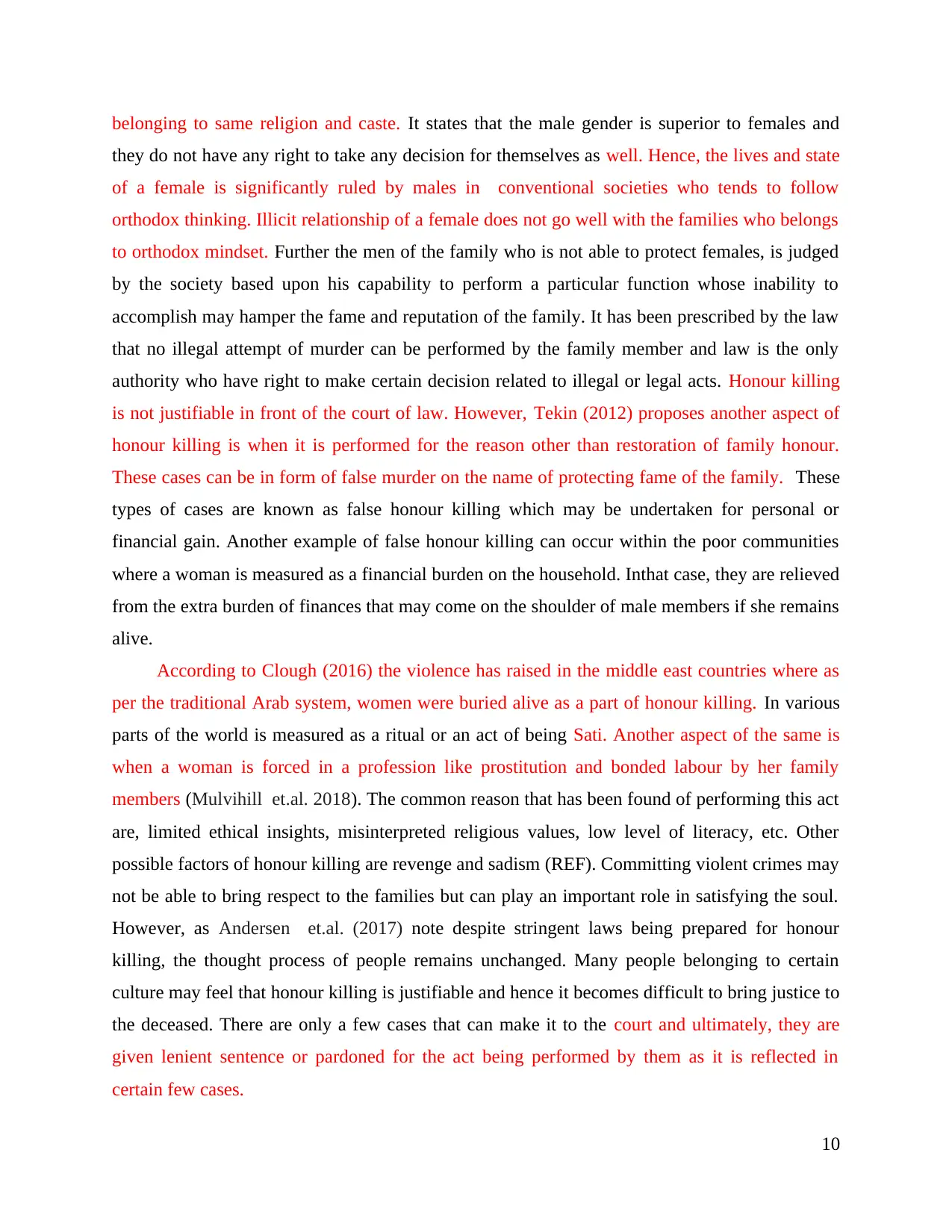
belonging to same religion and caste. It states that the male gender is superior to females and
they do not have any right to take any decision for themselves as well. Hence, the lives and state
of a female is significantly ruled by males in conventional societies who tends to follow
orthodox thinking. Illicit relationship of a female does not go well with the families who belongs
to orthodox mindset. Further the men of the family who is not able to protect females, is judged
by the society based upon his capability to perform a particular function whose inability to
accomplish may hamper the fame and reputation of the family. It has been prescribed by the law
that no illegal attempt of murder can be performed by the family member and law is the only
authority who have right to make certain decision related to illegal or legal acts. Honour killing
is not justifiable in front of the court of law. However, Tekin (2012) proposes another aspect of
honour killing is when it is performed for the reason other than restoration of family honour.
These cases can be in form of false murder on the name of protecting fame of the family. These
types of cases are known as false honour killing which may be undertaken for personal or
financial gain. Another example of false honour killing can occur within the poor communities
where a woman is measured as a financial burden on the household. Inthat case, they are relieved
from the extra burden of finances that may come on the shoulder of male members if she remains
alive.
According to Clough (2016) the violence has raised in the middle east countries where as
per the traditional Arab system, women were buried alive as a part of honour killing. In various
parts of the world is measured as a ritual or an act of being Sati. Another aspect of the same is
when a woman is forced in a profession like prostitution and bonded labour by her family
members (Mulvihill et.al. 2018). The common reason that has been found of performing this act
are, limited ethical insights, misinterpreted religious values, low level of literacy, etc. Other
possible factors of honour killing are revenge and sadism (REF). Committing violent crimes may
not be able to bring respect to the families but can play an important role in satisfying the soul.
However, as Andersen et.al. (2017) note despite stringent laws being prepared for honour
killing, the thought process of people remains unchanged. Many people belonging to certain
culture may feel that honour killing is justifiable and hence it becomes difficult to bring justice to
the deceased. There are only a few cases that can make it to the court and ultimately, they are
given lenient sentence or pardoned for the act being performed by them as it is reflected in
certain few cases.
10
they do not have any right to take any decision for themselves as well. Hence, the lives and state
of a female is significantly ruled by males in conventional societies who tends to follow
orthodox thinking. Illicit relationship of a female does not go well with the families who belongs
to orthodox mindset. Further the men of the family who is not able to protect females, is judged
by the society based upon his capability to perform a particular function whose inability to
accomplish may hamper the fame and reputation of the family. It has been prescribed by the law
that no illegal attempt of murder can be performed by the family member and law is the only
authority who have right to make certain decision related to illegal or legal acts. Honour killing
is not justifiable in front of the court of law. However, Tekin (2012) proposes another aspect of
honour killing is when it is performed for the reason other than restoration of family honour.
These cases can be in form of false murder on the name of protecting fame of the family. These
types of cases are known as false honour killing which may be undertaken for personal or
financial gain. Another example of false honour killing can occur within the poor communities
where a woman is measured as a financial burden on the household. Inthat case, they are relieved
from the extra burden of finances that may come on the shoulder of male members if she remains
alive.
According to Clough (2016) the violence has raised in the middle east countries where as
per the traditional Arab system, women were buried alive as a part of honour killing. In various
parts of the world is measured as a ritual or an act of being Sati. Another aspect of the same is
when a woman is forced in a profession like prostitution and bonded labour by her family
members (Mulvihill et.al. 2018). The common reason that has been found of performing this act
are, limited ethical insights, misinterpreted religious values, low level of literacy, etc. Other
possible factors of honour killing are revenge and sadism (REF). Committing violent crimes may
not be able to bring respect to the families but can play an important role in satisfying the soul.
However, as Andersen et.al. (2017) note despite stringent laws being prepared for honour
killing, the thought process of people remains unchanged. Many people belonging to certain
culture may feel that honour killing is justifiable and hence it becomes difficult to bring justice to
the deceased. There are only a few cases that can make it to the court and ultimately, they are
given lenient sentence or pardoned for the act being performed by them as it is reflected in
certain few cases.
10
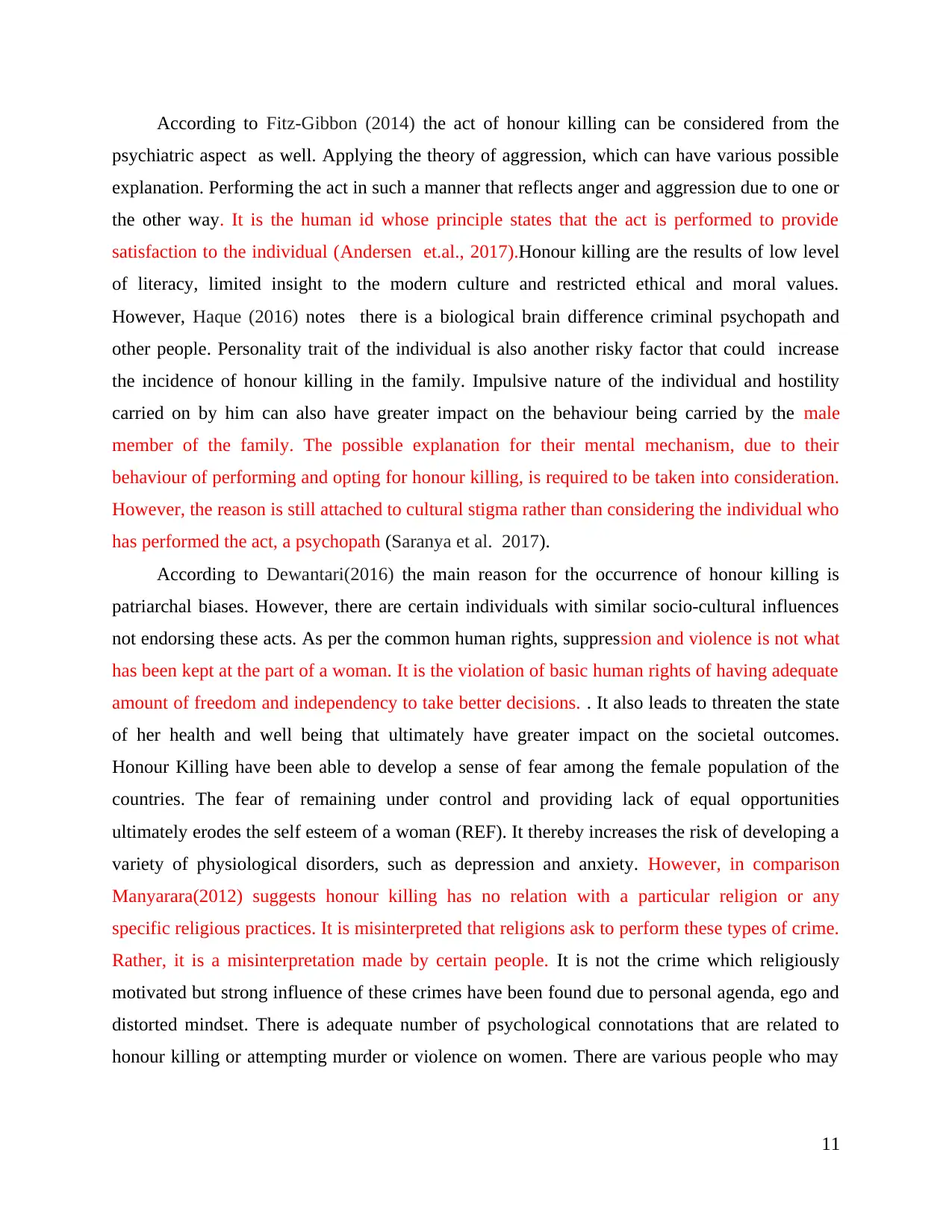
According to Fitz-Gibbon (2014) the act of honour killing can be considered from the
psychiatric aspect as well. Applying the theory of aggression, which can have various possible
explanation. Performing the act in such a manner that reflects anger and aggression due to one or
the other way. It is the human id whose principle states that the act is performed to provide
satisfaction to the individual (Andersen et.al., 2017).Honour killing are the results of low level
of literacy, limited insight to the modern culture and restricted ethical and moral values.
However, Haque (2016) notes there is a biological brain difference criminal psychopath and
other people. Personality trait of the individual is also another risky factor that could increase
the incidence of honour killing in the family. Impulsive nature of the individual and hostility
carried on by him can also have greater impact on the behaviour being carried by the male
member of the family. The possible explanation for their mental mechanism, due to their
behaviour of performing and opting for honour killing, is required to be taken into consideration.
However, the reason is still attached to cultural stigma rather than considering the individual who
has performed the act, a psychopath (Saranya et al. 2017).
According to Dewantari(2016) the main reason for the occurrence of honour killing is
patriarchal biases. However, there are certain individuals with similar socio-cultural influences
not endorsing these acts. As per the common human rights, suppression and violence is not what
has been kept at the part of a woman. It is the violation of basic human rights of having adequate
amount of freedom and independency to take better decisions. . It also leads to threaten the state
of her health and well being that ultimately have greater impact on the societal outcomes.
Honour Killing have been able to develop a sense of fear among the female population of the
countries. The fear of remaining under control and providing lack of equal opportunities
ultimately erodes the self esteem of a woman (REF). It thereby increases the risk of developing a
variety of physiological disorders, such as depression and anxiety. However, in comparison
Manyarara(2012) suggests honour killing has no relation with a particular religion or any
specific religious practices. It is misinterpreted that religions ask to perform these types of crime.
Rather, it is a misinterpretation made by certain people. It is not the crime which religiously
motivated but strong influence of these crimes have been found due to personal agenda, ego and
distorted mindset. There is adequate number of psychological connotations that are related to
honour killing or attempting murder or violence on women. There are various people who may
11
psychiatric aspect as well. Applying the theory of aggression, which can have various possible
explanation. Performing the act in such a manner that reflects anger and aggression due to one or
the other way. It is the human id whose principle states that the act is performed to provide
satisfaction to the individual (Andersen et.al., 2017).Honour killing are the results of low level
of literacy, limited insight to the modern culture and restricted ethical and moral values.
However, Haque (2016) notes there is a biological brain difference criminal psychopath and
other people. Personality trait of the individual is also another risky factor that could increase
the incidence of honour killing in the family. Impulsive nature of the individual and hostility
carried on by him can also have greater impact on the behaviour being carried by the male
member of the family. The possible explanation for their mental mechanism, due to their
behaviour of performing and opting for honour killing, is required to be taken into consideration.
However, the reason is still attached to cultural stigma rather than considering the individual who
has performed the act, a psychopath (Saranya et al. 2017).
According to Dewantari(2016) the main reason for the occurrence of honour killing is
patriarchal biases. However, there are certain individuals with similar socio-cultural influences
not endorsing these acts. As per the common human rights, suppression and violence is not what
has been kept at the part of a woman. It is the violation of basic human rights of having adequate
amount of freedom and independency to take better decisions. . It also leads to threaten the state
of her health and well being that ultimately have greater impact on the societal outcomes.
Honour Killing have been able to develop a sense of fear among the female population of the
countries. The fear of remaining under control and providing lack of equal opportunities
ultimately erodes the self esteem of a woman (REF). It thereby increases the risk of developing a
variety of physiological disorders, such as depression and anxiety. However, in comparison
Manyarara(2012) suggests honour killing has no relation with a particular religion or any
specific religious practices. It is misinterpreted that religions ask to perform these types of crime.
Rather, it is a misinterpretation made by certain people. It is not the crime which religiously
motivated but strong influence of these crimes have been found due to personal agenda, ego and
distorted mindset. There is adequate number of psychological connotations that are related to
honour killing or attempting murder or violence on women. There are various people who may
11
Paraphrase This Document
Need a fresh take? Get an instant paraphrase of this document with our AI Paraphraser
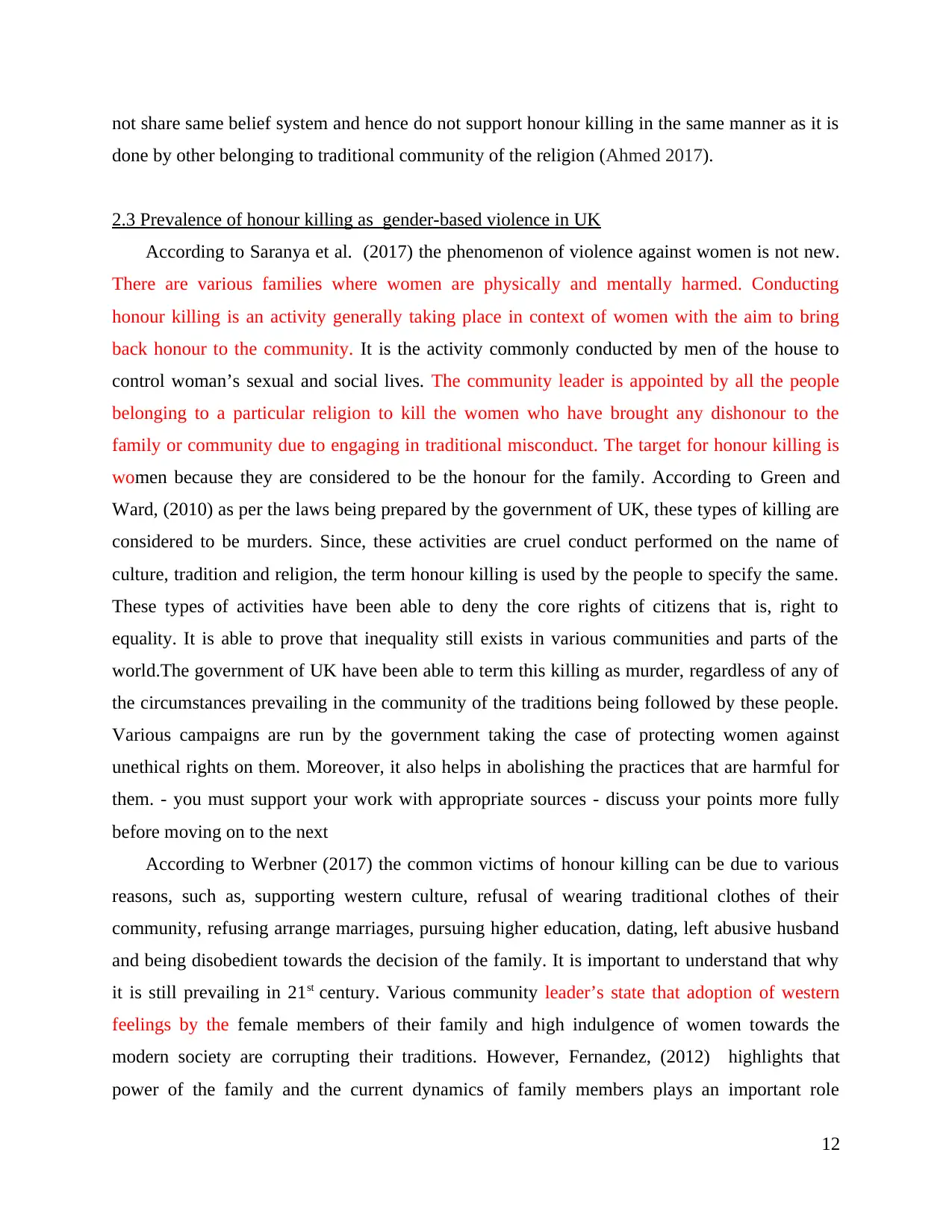
not share same belief system and hence do not support honour killing in the same manner as it is
done by other belonging to traditional community of the religion (Ahmed 2017).
2.3 Prevalence of honour killing as gender-based violence in UK
According to Saranya et al. (2017) the phenomenon of violence against women is not new.
There are various families where women are physically and mentally harmed. Conducting
honour killing is an activity generally taking place in context of women with the aim to bring
back honour to the community. It is the activity commonly conducted by men of the house to
control woman’s sexual and social lives. The community leader is appointed by all the people
belonging to a particular religion to kill the women who have brought any dishonour to the
family or community due to engaging in traditional misconduct. The target for honour killing is
women because they are considered to be the honour for the family. According to Green and
Ward, (2010) as per the laws being prepared by the government of UK, these types of killing are
considered to be murders. Since, these activities are cruel conduct performed on the name of
culture, tradition and religion, the term honour killing is used by the people to specify the same.
These types of activities have been able to deny the core rights of citizens that is, right to
equality. It is able to prove that inequality still exists in various communities and parts of the
world.The government of UK have been able to term this killing as murder, regardless of any of
the circumstances prevailing in the community of the traditions being followed by these people.
Various campaigns are run by the government taking the case of protecting women against
unethical rights on them. Moreover, it also helps in abolishing the practices that are harmful for
them. - you must support your work with appropriate sources - discuss your points more fully
before moving on to the next
According to Werbner (2017) the common victims of honour killing can be due to various
reasons, such as, supporting western culture, refusal of wearing traditional clothes of their
community, refusing arrange marriages, pursuing higher education, dating, left abusive husband
and being disobedient towards the decision of the family. It is important to understand that why
it is still prevailing in 21st century. Various community leader’s state that adoption of western
feelings by the female members of their family and high indulgence of women towards the
modern society are corrupting their traditions. However, Fernandez, (2012) highlights that
power of the family and the current dynamics of family members plays an important role
12
done by other belonging to traditional community of the religion (Ahmed 2017).
2.3 Prevalence of honour killing as gender-based violence in UK
According to Saranya et al. (2017) the phenomenon of violence against women is not new.
There are various families where women are physically and mentally harmed. Conducting
honour killing is an activity generally taking place in context of women with the aim to bring
back honour to the community. It is the activity commonly conducted by men of the house to
control woman’s sexual and social lives. The community leader is appointed by all the people
belonging to a particular religion to kill the women who have brought any dishonour to the
family or community due to engaging in traditional misconduct. The target for honour killing is
women because they are considered to be the honour for the family. According to Green and
Ward, (2010) as per the laws being prepared by the government of UK, these types of killing are
considered to be murders. Since, these activities are cruel conduct performed on the name of
culture, tradition and religion, the term honour killing is used by the people to specify the same.
These types of activities have been able to deny the core rights of citizens that is, right to
equality. It is able to prove that inequality still exists in various communities and parts of the
world.The government of UK have been able to term this killing as murder, regardless of any of
the circumstances prevailing in the community of the traditions being followed by these people.
Various campaigns are run by the government taking the case of protecting women against
unethical rights on them. Moreover, it also helps in abolishing the practices that are harmful for
them. - you must support your work with appropriate sources - discuss your points more fully
before moving on to the next
According to Werbner (2017) the common victims of honour killing can be due to various
reasons, such as, supporting western culture, refusal of wearing traditional clothes of their
community, refusing arrange marriages, pursuing higher education, dating, left abusive husband
and being disobedient towards the decision of the family. It is important to understand that why
it is still prevailing in 21st century. Various community leader’s state that adoption of western
feelings by the female members of their family and high indulgence of women towards the
modern society are corrupting their traditions. However, Fernandez, (2012) highlights that
power of the family and the current dynamics of family members plays an important role
12
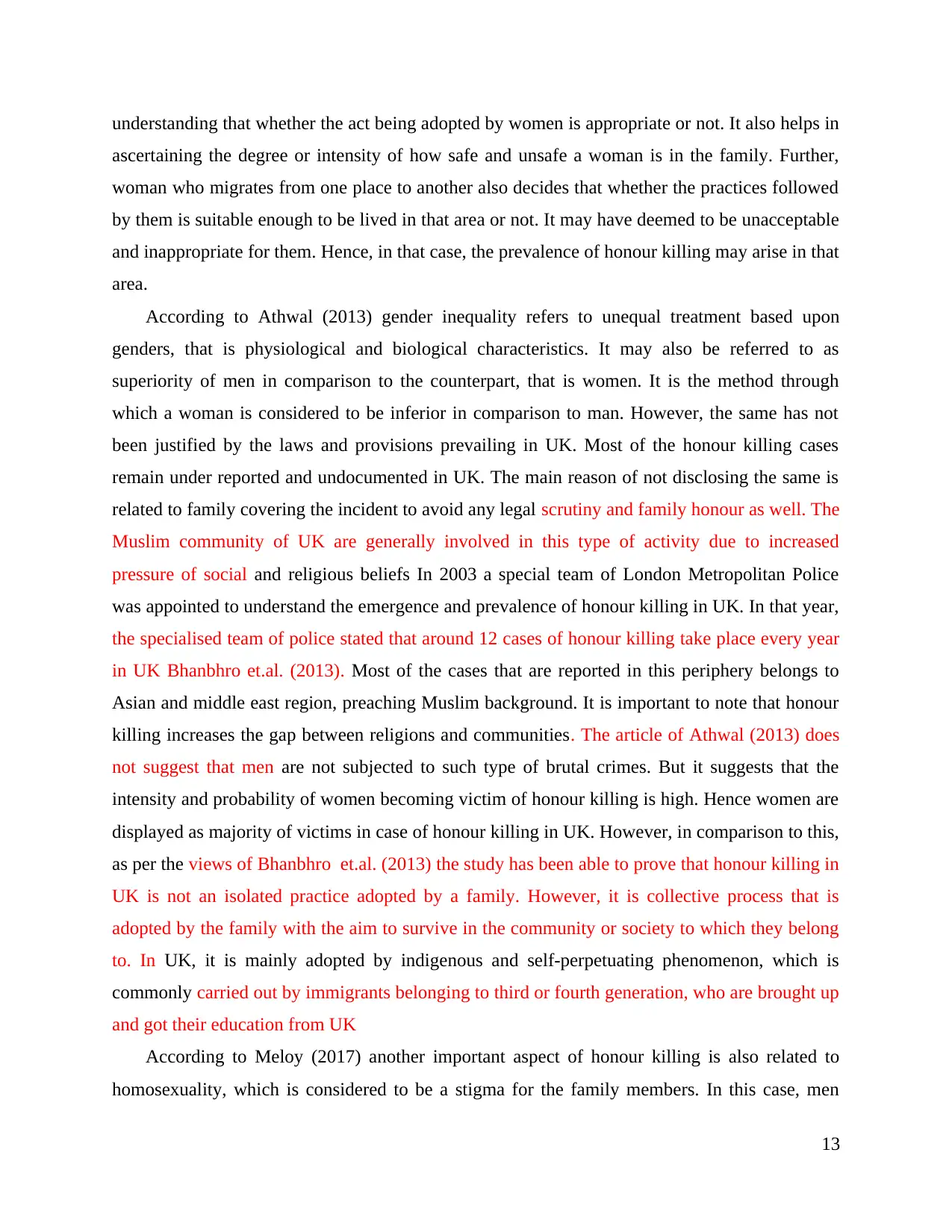
understanding that whether the act being adopted by women is appropriate or not. It also helps in
ascertaining the degree or intensity of how safe and unsafe a woman is in the family. Further,
woman who migrates from one place to another also decides that whether the practices followed
by them is suitable enough to be lived in that area or not. It may have deemed to be unacceptable
and inappropriate for them. Hence, in that case, the prevalence of honour killing may arise in that
area.
According to Athwal (2013) gender inequality refers to unequal treatment based upon
genders, that is physiological and biological characteristics. It may also be referred to as
superiority of men in comparison to the counterpart, that is women. It is the method through
which a woman is considered to be inferior in comparison to man. However, the same has not
been justified by the laws and provisions prevailing in UK. Most of the honour killing cases
remain under reported and undocumented in UK. The main reason of not disclosing the same is
related to family covering the incident to avoid any legal scrutiny and family honour as well. The
Muslim community of UK are generally involved in this type of activity due to increased
pressure of social and religious beliefs In 2003 a special team of London Metropolitan Police
was appointed to understand the emergence and prevalence of honour killing in UK. In that year,
the specialised team of police stated that around 12 cases of honour killing take place every year
in UK Bhanbhro et.al. (2013). Most of the cases that are reported in this periphery belongs to
Asian and middle east region, preaching Muslim background. It is important to note that honour
killing increases the gap between religions and communities. The article of Athwal (2013) does
not suggest that men are not subjected to such type of brutal crimes. But it suggests that the
intensity and probability of women becoming victim of honour killing is high. Hence women are
displayed as majority of victims in case of honour killing in UK. However, in comparison to this,
as per the views of Bhanbhro et.al. (2013) the study has been able to prove that honour killing in
UK is not an isolated practice adopted by a family. However, it is collective process that is
adopted by the family with the aim to survive in the community or society to which they belong
to. In UK, it is mainly adopted by indigenous and self-perpetuating phenomenon, which is
commonly carried out by immigrants belonging to third or fourth generation, who are brought up
and got their education from UK
According to Meloy (2017) another important aspect of honour killing is also related to
homosexuality, which is considered to be a stigma for the family members. In this case, men
13
ascertaining the degree or intensity of how safe and unsafe a woman is in the family. Further,
woman who migrates from one place to another also decides that whether the practices followed
by them is suitable enough to be lived in that area or not. It may have deemed to be unacceptable
and inappropriate for them. Hence, in that case, the prevalence of honour killing may arise in that
area.
According to Athwal (2013) gender inequality refers to unequal treatment based upon
genders, that is physiological and biological characteristics. It may also be referred to as
superiority of men in comparison to the counterpart, that is women. It is the method through
which a woman is considered to be inferior in comparison to man. However, the same has not
been justified by the laws and provisions prevailing in UK. Most of the honour killing cases
remain under reported and undocumented in UK. The main reason of not disclosing the same is
related to family covering the incident to avoid any legal scrutiny and family honour as well. The
Muslim community of UK are generally involved in this type of activity due to increased
pressure of social and religious beliefs In 2003 a special team of London Metropolitan Police
was appointed to understand the emergence and prevalence of honour killing in UK. In that year,
the specialised team of police stated that around 12 cases of honour killing take place every year
in UK Bhanbhro et.al. (2013). Most of the cases that are reported in this periphery belongs to
Asian and middle east region, preaching Muslim background. It is important to note that honour
killing increases the gap between religions and communities. The article of Athwal (2013) does
not suggest that men are not subjected to such type of brutal crimes. But it suggests that the
intensity and probability of women becoming victim of honour killing is high. Hence women are
displayed as majority of victims in case of honour killing in UK. However, in comparison to this,
as per the views of Bhanbhro et.al. (2013) the study has been able to prove that honour killing in
UK is not an isolated practice adopted by a family. However, it is collective process that is
adopted by the family with the aim to survive in the community or society to which they belong
to. In UK, it is mainly adopted by indigenous and self-perpetuating phenomenon, which is
commonly carried out by immigrants belonging to third or fourth generation, who are brought up
and got their education from UK
According to Meloy (2017) another important aspect of honour killing is also related to
homosexuality, which is considered to be a stigma for the family members. In this case, men
13

tend to face no less consequences than a woman by the community or society leader to which it
belongs to. However, men becoming victim of honour killing cannot be termed as gender-based
violence. However, Shah Kakakhel, (2014) believes that honour killing is a complex legal issue
that is measured by the government of UK with care. There is various other muslin dominant
countries who may not treat it as an offence. However, the same is seen as a criminal activity as
per the laws and provisions of UK. Honour killing falls under the criminal code which is
commonly governed by homicide under The Homicide Act 1957. Any other serious offence
related to the subject matter can also come under the periphery of Offences Against the Person
Act 1861. Hence, the individual who has performed the shame activity is punished by law in UK.
There are various people who tends to seek defence on the name of culture or tradition. They
defend themselves and justify their acts as customary norms. - has there not been specific
legislation introduced in respect of honour killing and other related crimes?
14
belongs to. However, men becoming victim of honour killing cannot be termed as gender-based
violence. However, Shah Kakakhel, (2014) believes that honour killing is a complex legal issue
that is measured by the government of UK with care. There is various other muslin dominant
countries who may not treat it as an offence. However, the same is seen as a criminal activity as
per the laws and provisions of UK. Honour killing falls under the criminal code which is
commonly governed by homicide under The Homicide Act 1957. Any other serious offence
related to the subject matter can also come under the periphery of Offences Against the Person
Act 1861. Hence, the individual who has performed the shame activity is punished by law in UK.
There are various people who tends to seek defence on the name of culture or tradition. They
defend themselves and justify their acts as customary norms. - has there not been specific
legislation introduced in respect of honour killing and other related crimes?
14
Secure Best Marks with AI Grader
Need help grading? Try our AI Grader for instant feedback on your assignments.
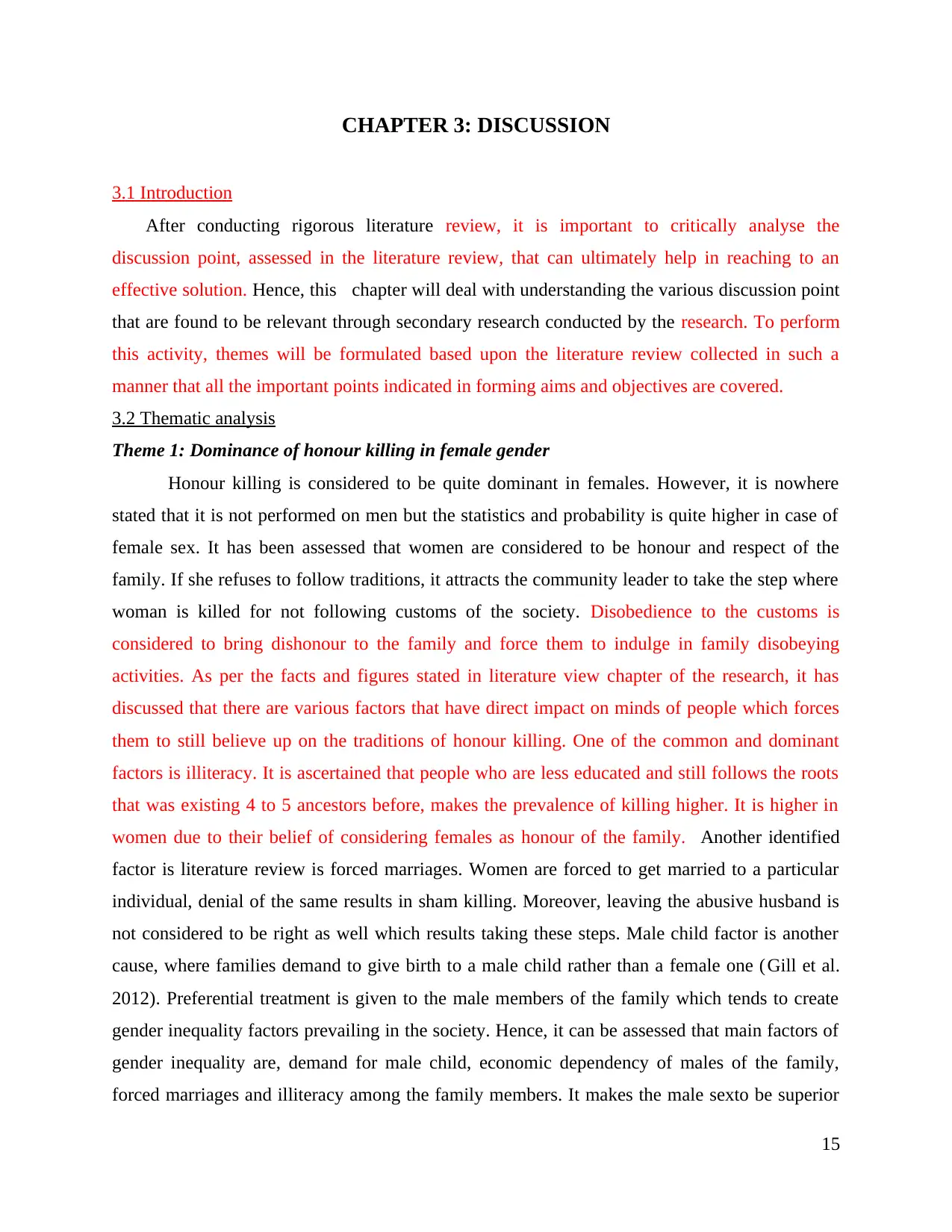
CHAPTER 3: DISCUSSION
3.1 Introduction
After conducting rigorous literature review, it is important to critically analyse the
discussion point, assessed in the literature review, that can ultimately help in reaching to an
effective solution. Hence, this chapter will deal with understanding the various discussion point
that are found to be relevant through secondary research conducted by the research. To perform
this activity, themes will be formulated based upon the literature review collected in such a
manner that all the important points indicated in forming aims and objectives are covered.
3.2 Thematic analysis
Theme 1: Dominance of honour killing in female gender
Honour killing is considered to be quite dominant in females. However, it is nowhere
stated that it is not performed on men but the statistics and probability is quite higher in case of
female sex. It has been assessed that women are considered to be honour and respect of the
family. If she refuses to follow traditions, it attracts the community leader to take the step where
woman is killed for not following customs of the society. Disobedience to the customs is
considered to bring dishonour to the family and force them to indulge in family disobeying
activities. As per the facts and figures stated in literature view chapter of the research, it has
discussed that there are various factors that have direct impact on minds of people which forces
them to still believe up on the traditions of honour killing. One of the common and dominant
factors is illiteracy. It is ascertained that people who are less educated and still follows the roots
that was existing 4 to 5 ancestors before, makes the prevalence of killing higher. It is higher in
women due to their belief of considering females as honour of the family. Another identified
factor is literature review is forced marriages. Women are forced to get married to a particular
individual, denial of the same results in sham killing. Moreover, leaving the abusive husband is
not considered to be right as well which results taking these steps. Male child factor is another
cause, where families demand to give birth to a male child rather than a female one (Gill et al.
2012). Preferential treatment is given to the male members of the family which tends to create
gender inequality factors prevailing in the society. Hence, it can be assessed that main factors of
gender inequality are, demand for male child, economic dependency of males of the family,
forced marriages and illiteracy among the family members. It makes the male sexto be superior
15
3.1 Introduction
After conducting rigorous literature review, it is important to critically analyse the
discussion point, assessed in the literature review, that can ultimately help in reaching to an
effective solution. Hence, this chapter will deal with understanding the various discussion point
that are found to be relevant through secondary research conducted by the research. To perform
this activity, themes will be formulated based upon the literature review collected in such a
manner that all the important points indicated in forming aims and objectives are covered.
3.2 Thematic analysis
Theme 1: Dominance of honour killing in female gender
Honour killing is considered to be quite dominant in females. However, it is nowhere
stated that it is not performed on men but the statistics and probability is quite higher in case of
female sex. It has been assessed that women are considered to be honour and respect of the
family. If she refuses to follow traditions, it attracts the community leader to take the step where
woman is killed for not following customs of the society. Disobedience to the customs is
considered to bring dishonour to the family and force them to indulge in family disobeying
activities. As per the facts and figures stated in literature view chapter of the research, it has
discussed that there are various factors that have direct impact on minds of people which forces
them to still believe up on the traditions of honour killing. One of the common and dominant
factors is illiteracy. It is ascertained that people who are less educated and still follows the roots
that was existing 4 to 5 ancestors before, makes the prevalence of killing higher. It is higher in
women due to their belief of considering females as honour of the family. Another identified
factor is literature review is forced marriages. Women are forced to get married to a particular
individual, denial of the same results in sham killing. Moreover, leaving the abusive husband is
not considered to be right as well which results taking these steps. Male child factor is another
cause, where families demand to give birth to a male child rather than a female one (Gill et al.
2012). Preferential treatment is given to the male members of the family which tends to create
gender inequality factors prevailing in the society. Hence, it can be assessed that main factors of
gender inequality are, demand for male child, economic dependency of males of the family,
forced marriages and illiteracy among the family members. It makes the male sexto be superior
15

enough from the female one where they can enjoy better rights and responsibilities in
comparison to the females. make sure the points you are making are relevant to the theme you
are exploring
Figure 2 Causes of gender inequality
(Source: Gill et al. 2012)
How does this figure connect to honour killing and female gender prevalence?
Theme 2: High prevalence of honour killing as gender-based violence
Honour killing have been able to establish itself as a gender-based violence. The research
has been able to focus upon a feminist approach where honour lies within the patriarchal
societies of the country. The act of honour killing is often viewed as cultural and traditional
practices adopted by the communities. There is various researcher which have been able to prove
that honour killing have direct relation to gender biasness. Honour essentially involves
maintaining strict code of conduct that is required to be followed by the females of the house and
a firm control is also maintained upon behaviour on women by putting certain regulations on
them. Women are considered to be virtuous since birth and the same is required to be maintained
by them to the rest of their lives. Society believes that any stain on the chastity of woman is
disobey to the male members of the family. The sexuality of a women is brought to a strict
scrutiny which they ned to protect till they are not married. Inability to perform the same attracts
them towards dishonour and leads to honour killing. Involving in acceptable practices is
16
comparison to the females. make sure the points you are making are relevant to the theme you
are exploring
Figure 2 Causes of gender inequality
(Source: Gill et al. 2012)
How does this figure connect to honour killing and female gender prevalence?
Theme 2: High prevalence of honour killing as gender-based violence
Honour killing have been able to establish itself as a gender-based violence. The research
has been able to focus upon a feminist approach where honour lies within the patriarchal
societies of the country. The act of honour killing is often viewed as cultural and traditional
practices adopted by the communities. There is various researcher which have been able to prove
that honour killing have direct relation to gender biasness. Honour essentially involves
maintaining strict code of conduct that is required to be followed by the females of the house and
a firm control is also maintained upon behaviour on women by putting certain regulations on
them. Women are considered to be virtuous since birth and the same is required to be maintained
by them to the rest of their lives. Society believes that any stain on the chastity of woman is
disobey to the male members of the family. The sexuality of a women is brought to a strict
scrutiny which they ned to protect till they are not married. Inability to perform the same attracts
them towards dishonour and leads to honour killing. Involving in acceptable practices is
16
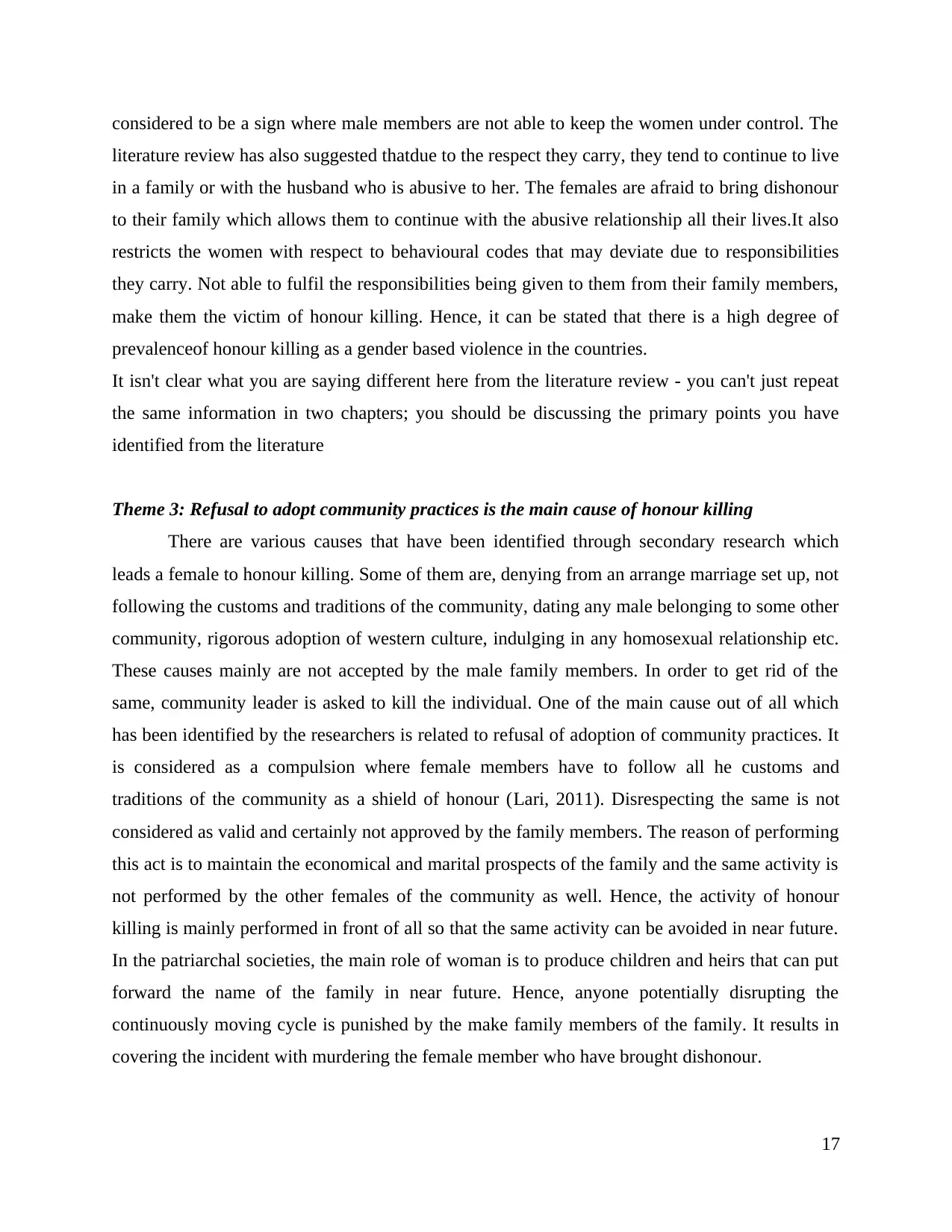
considered to be a sign where male members are not able to keep the women under control. The
literature review has also suggested thatdue to the respect they carry, they tend to continue to live
in a family or with the husband who is abusive to her. The females are afraid to bring dishonour
to their family which allows them to continue with the abusive relationship all their lives.It also
restricts the women with respect to behavioural codes that may deviate due to responsibilities
they carry. Not able to fulfil the responsibilities being given to them from their family members,
make them the victim of honour killing. Hence, it can be stated that there is a high degree of
prevalenceof honour killing as a gender based violence in the countries.
It isn't clear what you are saying different here from the literature review - you can't just repeat
the same information in two chapters; you should be discussing the primary points you have
identified from the literature
Theme 3: Refusal to adopt community practices is the main cause of honour killing
There are various causes that have been identified through secondary research which
leads a female to honour killing. Some of them are, denying from an arrange marriage set up, not
following the customs and traditions of the community, dating any male belonging to some other
community, rigorous adoption of western culture, indulging in any homosexual relationship etc.
These causes mainly are not accepted by the male family members. In order to get rid of the
same, community leader is asked to kill the individual. One of the main cause out of all which
has been identified by the researchers is related to refusal of adoption of community practices. It
is considered as a compulsion where female members have to follow all he customs and
traditions of the community as a shield of honour (Lari, 2011). Disrespecting the same is not
considered as valid and certainly not approved by the family members. The reason of performing
this act is to maintain the economical and marital prospects of the family and the same activity is
not performed by the other females of the community as well. Hence, the activity of honour
killing is mainly performed in front of all so that the same activity can be avoided in near future.
In the patriarchal societies, the main role of woman is to produce children and heirs that can put
forward the name of the family in near future. Hence, anyone potentially disrupting the
continuously moving cycle is punished by the make family members of the family. It results in
covering the incident with murdering the female member who have brought dishonour.
17
literature review has also suggested thatdue to the respect they carry, they tend to continue to live
in a family or with the husband who is abusive to her. The females are afraid to bring dishonour
to their family which allows them to continue with the abusive relationship all their lives.It also
restricts the women with respect to behavioural codes that may deviate due to responsibilities
they carry. Not able to fulfil the responsibilities being given to them from their family members,
make them the victim of honour killing. Hence, it can be stated that there is a high degree of
prevalenceof honour killing as a gender based violence in the countries.
It isn't clear what you are saying different here from the literature review - you can't just repeat
the same information in two chapters; you should be discussing the primary points you have
identified from the literature
Theme 3: Refusal to adopt community practices is the main cause of honour killing
There are various causes that have been identified through secondary research which
leads a female to honour killing. Some of them are, denying from an arrange marriage set up, not
following the customs and traditions of the community, dating any male belonging to some other
community, rigorous adoption of western culture, indulging in any homosexual relationship etc.
These causes mainly are not accepted by the male family members. In order to get rid of the
same, community leader is asked to kill the individual. One of the main cause out of all which
has been identified by the researchers is related to refusal of adoption of community practices. It
is considered as a compulsion where female members have to follow all he customs and
traditions of the community as a shield of honour (Lari, 2011). Disrespecting the same is not
considered as valid and certainly not approved by the family members. The reason of performing
this act is to maintain the economical and marital prospects of the family and the same activity is
not performed by the other females of the community as well. Hence, the activity of honour
killing is mainly performed in front of all so that the same activity can be avoided in near future.
In the patriarchal societies, the main role of woman is to produce children and heirs that can put
forward the name of the family in near future. Hence, anyone potentially disrupting the
continuously moving cycle is punished by the make family members of the family. It results in
covering the incident with murdering the female member who have brought dishonour.
17
Paraphrase This Document
Need a fresh take? Get an instant paraphrase of this document with our AI Paraphraser
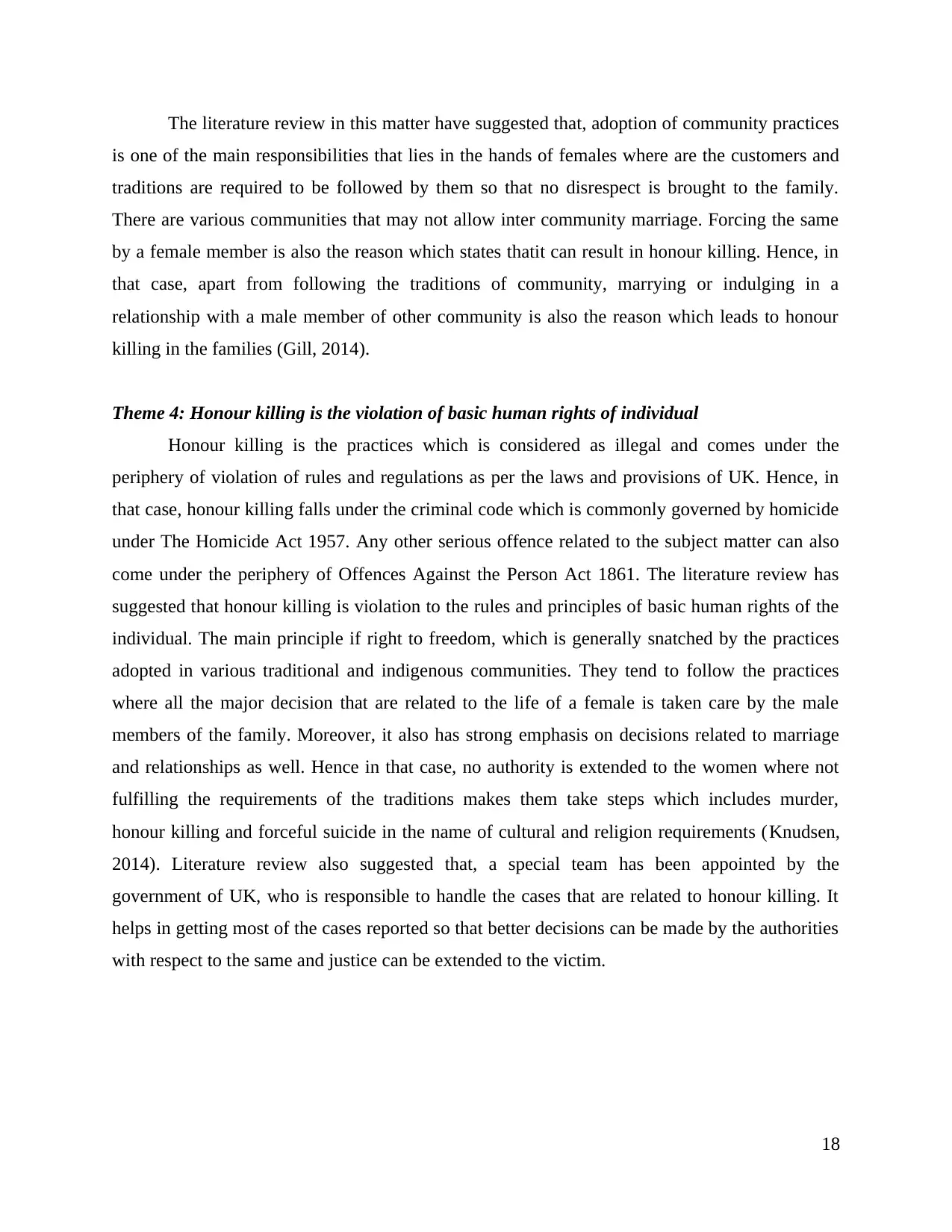
The literature review in this matter have suggested that, adoption of community practices
is one of the main responsibilities that lies in the hands of females where are the customers and
traditions are required to be followed by them so that no disrespect is brought to the family.
There are various communities that may not allow inter community marriage. Forcing the same
by a female member is also the reason which states thatit can result in honour killing. Hence, in
that case, apart from following the traditions of community, marrying or indulging in a
relationship with a male member of other community is also the reason which leads to honour
killing in the families (Gill, 2014).
Theme 4: Honour killing is the violation of basic human rights of individual
Honour killing is the practices which is considered as illegal and comes under the
periphery of violation of rules and regulations as per the laws and provisions of UK. Hence, in
that case, honour killing falls under the criminal code which is commonly governed by homicide
under The Homicide Act 1957. Any other serious offence related to the subject matter can also
come under the periphery of Offences Against the Person Act 1861. The literature review has
suggested that honour killing is violation to the rules and principles of basic human rights of the
individual. The main principle if right to freedom, which is generally snatched by the practices
adopted in various traditional and indigenous communities. They tend to follow the practices
where all the major decision that are related to the life of a female is taken care by the male
members of the family. Moreover, it also has strong emphasis on decisions related to marriage
and relationships as well. Hence in that case, no authority is extended to the women where not
fulfilling the requirements of the traditions makes them take steps which includes murder,
honour killing and forceful suicide in the name of cultural and religion requirements (Knudsen,
2014). Literature review also suggested that, a special team has been appointed by the
government of UK, who is responsible to handle the cases that are related to honour killing. It
helps in getting most of the cases reported so that better decisions can be made by the authorities
with respect to the same and justice can be extended to the victim.
18
is one of the main responsibilities that lies in the hands of females where are the customers and
traditions are required to be followed by them so that no disrespect is brought to the family.
There are various communities that may not allow inter community marriage. Forcing the same
by a female member is also the reason which states thatit can result in honour killing. Hence, in
that case, apart from following the traditions of community, marrying or indulging in a
relationship with a male member of other community is also the reason which leads to honour
killing in the families (Gill, 2014).
Theme 4: Honour killing is the violation of basic human rights of individual
Honour killing is the practices which is considered as illegal and comes under the
periphery of violation of rules and regulations as per the laws and provisions of UK. Hence, in
that case, honour killing falls under the criminal code which is commonly governed by homicide
under The Homicide Act 1957. Any other serious offence related to the subject matter can also
come under the periphery of Offences Against the Person Act 1861. The literature review has
suggested that honour killing is violation to the rules and principles of basic human rights of the
individual. The main principle if right to freedom, which is generally snatched by the practices
adopted in various traditional and indigenous communities. They tend to follow the practices
where all the major decision that are related to the life of a female is taken care by the male
members of the family. Moreover, it also has strong emphasis on decisions related to marriage
and relationships as well. Hence in that case, no authority is extended to the women where not
fulfilling the requirements of the traditions makes them take steps which includes murder,
honour killing and forceful suicide in the name of cultural and religion requirements (Knudsen,
2014). Literature review also suggested that, a special team has been appointed by the
government of UK, who is responsible to handle the cases that are related to honour killing. It
helps in getting most of the cases reported so that better decisions can be made by the authorities
with respect to the same and justice can be extended to the victim.
18

CHAPTER 4: CONCLUSION AND RECOMMENDATIONS
4.1 Conclusion
The present research aims at critically assessing the prevalence of honour killing as a
gender-based violence in UK. The study helped in understanding various aspects that have direct
relation to honour killing.
In the literature review chapter of the research, all the data being collected from the
secondary sources is analysed. Themes were formulated so as to keep the analysis aspect deeper.
It helped in ascertaining that honour killing is not only related to directly murdering the
individual, but forceful suicide also comes under its periphery. Violence related to honour killing
is rather have more existence in females as they are considered to be weak section of the society
who do not have any right to make their own decisions. Hence, male members have the right to
indulge in such decisions which are related to marriage or education or any other verdict for the
life of a female.
The first objective of the research was to understand various aspects of honour killing.
Illicit relationship of the female with the other male member is not generally accepted by the
family. It is considered as one of the important aspects of committing an honour killing
(Alizadeh et.al. 2010). It is judged as the incapability of men to protect of restricts the woman of
his family fromindulging in these activities.Other aspect of honour killing is that when this
activity is performed other than reason of restoring honour.
Females are also considered as financial burden on the family which is required to be
reduced through this act. However, on the other hand, various traditions have been able to justify
their act based upon tradition and customary requirements of their religion.It is also considered
to as a retaliation activity which is commonly performed as a reflection of any act that has
already been performed by the female member of the family.
The other objective of the researcher was to ascertain the prevalence of honour killing as a
gender-based violence in UK. The research also states that despite of presence of stringent laws,
the thought process of people involved regarding honour killing remains unchanged. They are
the people who may not abolish their criminal activities on the name of laws.
Overall, it can be concluded that honour killing have been able to become a gender-based
violence as majority of the victims being reported through the same are females.
19
4.1 Conclusion
The present research aims at critically assessing the prevalence of honour killing as a
gender-based violence in UK. The study helped in understanding various aspects that have direct
relation to honour killing.
In the literature review chapter of the research, all the data being collected from the
secondary sources is analysed. Themes were formulated so as to keep the analysis aspect deeper.
It helped in ascertaining that honour killing is not only related to directly murdering the
individual, but forceful suicide also comes under its periphery. Violence related to honour killing
is rather have more existence in females as they are considered to be weak section of the society
who do not have any right to make their own decisions. Hence, male members have the right to
indulge in such decisions which are related to marriage or education or any other verdict for the
life of a female.
The first objective of the research was to understand various aspects of honour killing.
Illicit relationship of the female with the other male member is not generally accepted by the
family. It is considered as one of the important aspects of committing an honour killing
(Alizadeh et.al. 2010). It is judged as the incapability of men to protect of restricts the woman of
his family fromindulging in these activities.Other aspect of honour killing is that when this
activity is performed other than reason of restoring honour.
Females are also considered as financial burden on the family which is required to be
reduced through this act. However, on the other hand, various traditions have been able to justify
their act based upon tradition and customary requirements of their religion.It is also considered
to as a retaliation activity which is commonly performed as a reflection of any act that has
already been performed by the female member of the family.
The other objective of the researcher was to ascertain the prevalence of honour killing as a
gender-based violence in UK. The research also states that despite of presence of stringent laws,
the thought process of people involved regarding honour killing remains unchanged. They are
the people who may not abolish their criminal activities on the name of laws.
Overall, it can be concluded that honour killing have been able to become a gender-based
violence as majority of the victims being reported through the same are females.
19

4.2 Recommendations
Honour killings have been able to become a setback for the countries which requires serious
actions to be taken by government and citizens of the country aswell. Hence, in that case, various
recommendations that can be used in reducing the prevalence of honour killing are as follows:
Educational campaigns: One of the important aspects of understanding honour killings
is education. Prevailing illiteracy in the country forces the families to believe on such
tradition that involved criminal activities. The violent practices can be stopped or
reduced to an extend through educational campaign where different perspective of
honour killing can be shown to the families. Further, campaigning regarding basic
human rights of an individual, irrespective of the gender they belong to, is another aspect
that can help in reducing the incidence of honour killing (Dewantari 2016).
Developing understanding regarding honour code: It is important to make people
understand regarding the concept of honour killing. The revolution of ideas is also
required to be discussed. Organizing debates and knowledgeable sessions are the other
ways that can be adopted by the government of UK so that knowledge regarding the
same can be enhanced to the core. One of the core reason of continuation of honour
killing till now is expectation of the families to perform the same which was performed
earlier. Hence, in that case, developing their knowledge base can help in dealing with the
issue. Fighting misogyny: Another important aspect that is to be considered by the
government is to understand the misrepresentation of culture being made by the
interpreter of religion. Avoiding any stereotypes and abusive cultural representation that
follow of increase the intensity of honour killing can help in dealing with the issue and
making people understand regarding the same. It is the wrong perception that has been
made by the people where it is important to explain the real meaning of being worthy
and honour (Manyarara 2012). The transformation of attitude among people can help in
challenging the practice of hon our killing to the core. Helping people at risk: Understanding the factors of risk and helping people to fight
with the unjustifiable practice can help in strengthening the condition of females. Hence,
in that case, adequate amount of help can be asked from doctors, health care
20
Honour killings have been able to become a setback for the countries which requires serious
actions to be taken by government and citizens of the country aswell. Hence, in that case, various
recommendations that can be used in reducing the prevalence of honour killing are as follows:
Educational campaigns: One of the important aspects of understanding honour killings
is education. Prevailing illiteracy in the country forces the families to believe on such
tradition that involved criminal activities. The violent practices can be stopped or
reduced to an extend through educational campaign where different perspective of
honour killing can be shown to the families. Further, campaigning regarding basic
human rights of an individual, irrespective of the gender they belong to, is another aspect
that can help in reducing the incidence of honour killing (Dewantari 2016).
Developing understanding regarding honour code: It is important to make people
understand regarding the concept of honour killing. The revolution of ideas is also
required to be discussed. Organizing debates and knowledgeable sessions are the other
ways that can be adopted by the government of UK so that knowledge regarding the
same can be enhanced to the core. One of the core reason of continuation of honour
killing till now is expectation of the families to perform the same which was performed
earlier. Hence, in that case, developing their knowledge base can help in dealing with the
issue. Fighting misogyny: Another important aspect that is to be considered by the
government is to understand the misrepresentation of culture being made by the
interpreter of religion. Avoiding any stereotypes and abusive cultural representation that
follow of increase the intensity of honour killing can help in dealing with the issue and
making people understand regarding the same. It is the wrong perception that has been
made by the people where it is important to explain the real meaning of being worthy
and honour (Manyarara 2012). The transformation of attitude among people can help in
challenging the practice of hon our killing to the core. Helping people at risk: Understanding the factors of risk and helping people to fight
with the unjustifiable practice can help in strengthening the condition of females. Hence,
in that case, adequate amount of help can be asked from doctors, health care
20
Secure Best Marks with AI Grader
Need help grading? Try our AI Grader for instant feedback on your assignments.
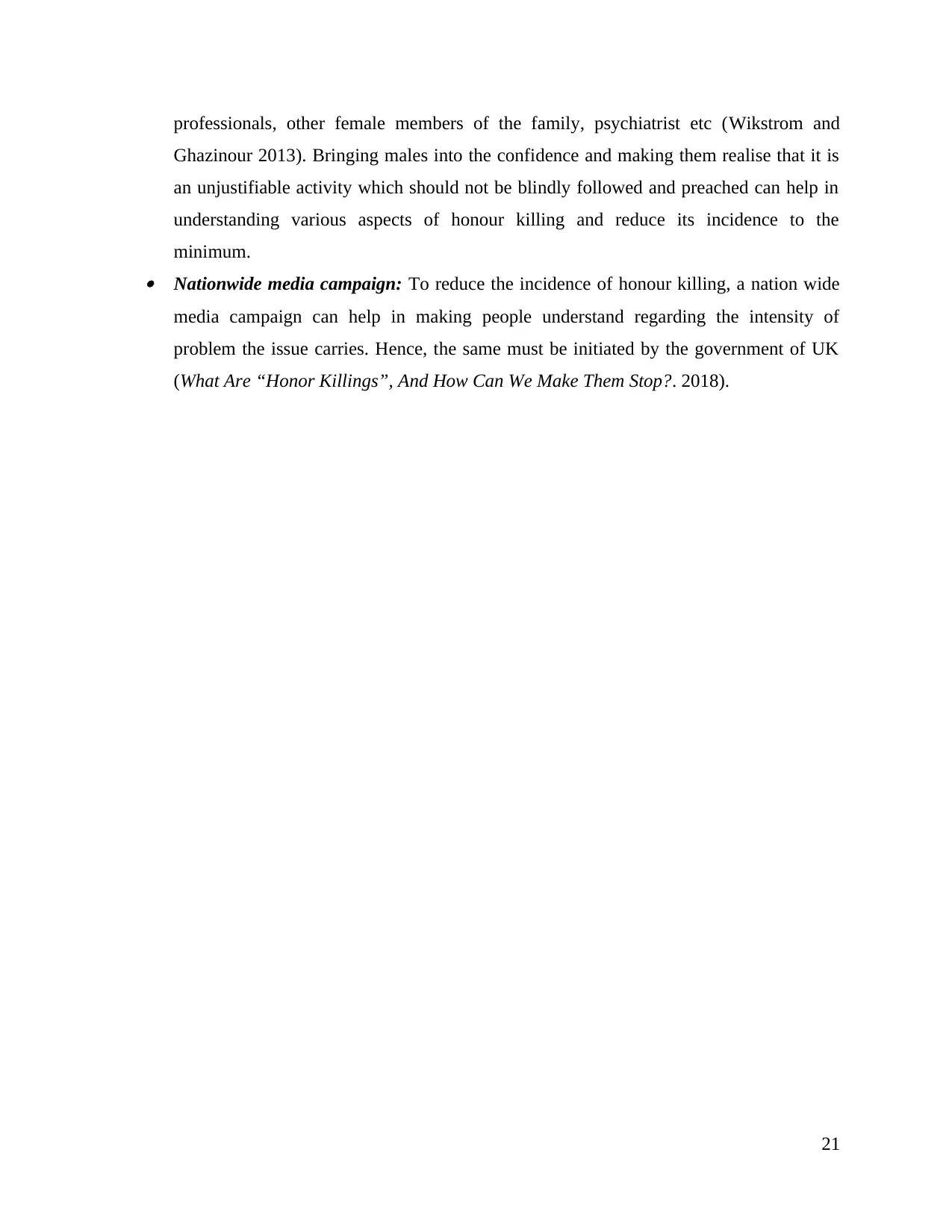
professionals, other female members of the family, psychiatrist etc (Wikstrom and
Ghazinour 2013). Bringing males into the confidence and making them realise that it is
an unjustifiable activity which should not be blindly followed and preached can help in
understanding various aspects of honour killing and reduce its incidence to the
minimum. Nationwide media campaign: To reduce the incidence of honour killing, a nation wide
media campaign can help in making people understand regarding the intensity of
problem the issue carries. Hence, the same must be initiated by the government of UK
(What Are “Honor Killings”, And How Can We Make Them Stop?. 2018).
21
Ghazinour 2013). Bringing males into the confidence and making them realise that it is
an unjustifiable activity which should not be blindly followed and preached can help in
understanding various aspects of honour killing and reduce its incidence to the
minimum. Nationwide media campaign: To reduce the incidence of honour killing, a nation wide
media campaign can help in making people understand regarding the intensity of
problem the issue carries. Hence, the same must be initiated by the government of UK
(What Are “Honor Killings”, And How Can We Make Them Stop?. 2018).
21
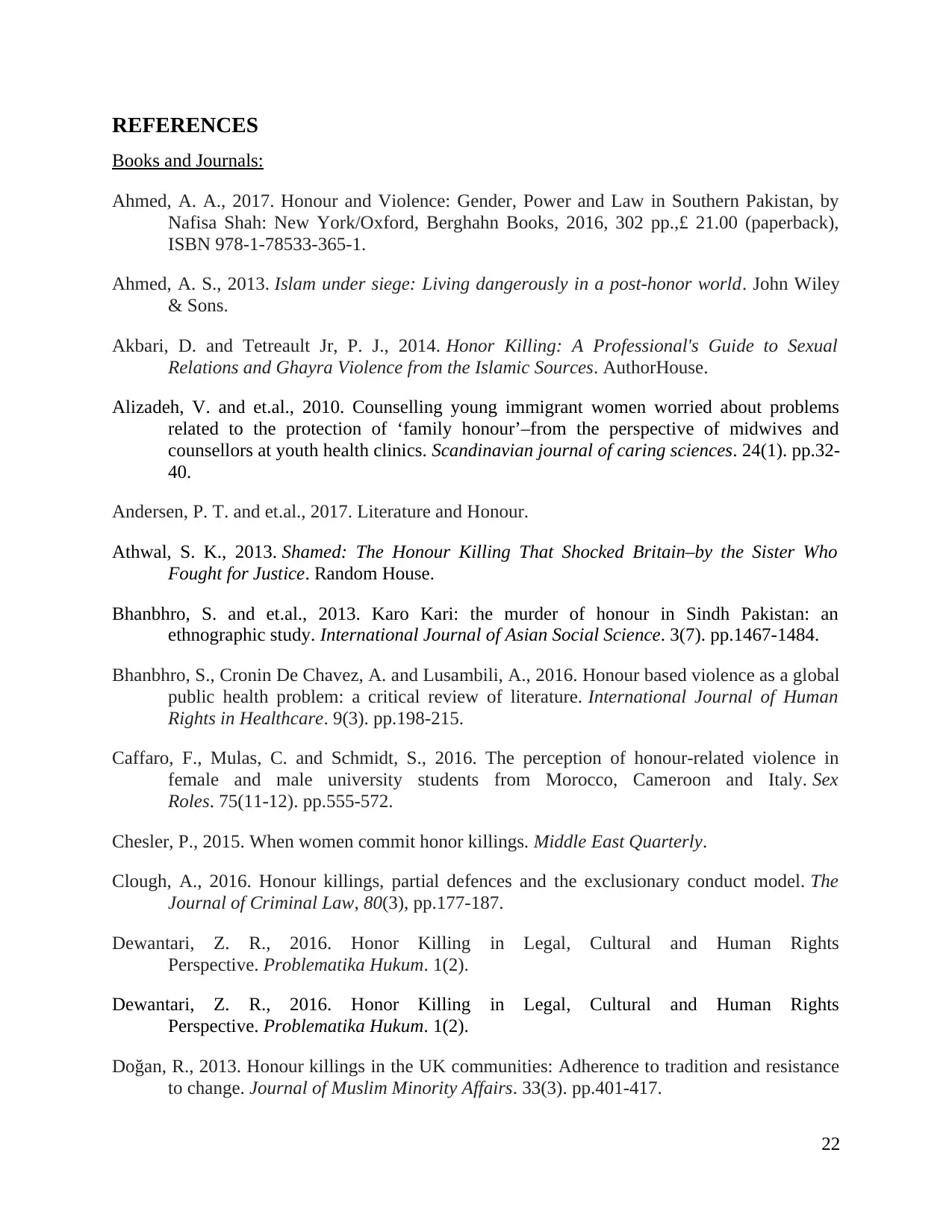
REFERENCES
Books and Journals:
Ahmed, A. A., 2017. Honour and Violence: Gender, Power and Law in Southern Pakistan, by
Nafisa Shah: New York/Oxford, Berghahn Books, 2016, 302 pp.,£ 21.00 (paperback),
ISBN 978-1-78533-365-1.
Ahmed, A. S., 2013. Islam under siege: Living dangerously in a post-honor world. John Wiley
& Sons.
Akbari, D. and Tetreault Jr, P. J., 2014. Honor Killing: A Professional's Guide to Sexual
Relations and Ghayra Violence from the Islamic Sources. AuthorHouse.
Alizadeh, V. and et.al., 2010. Counselling young immigrant women worried about problems
related to the protection of ‘family honour’–from the perspective of midwives and
counsellors at youth health clinics. Scandinavian journal of caring sciences. 24(1). pp.32-
40.
Andersen, P. T. and et.al., 2017. Literature and Honour.
Athwal, S. K., 2013. Shamed: The Honour Killing That Shocked Britain–by the Sister Who
Fought for Justice. Random House.
Bhanbhro, S. and et.al., 2013. Karo Kari: the murder of honour in Sindh Pakistan: an
ethnographic study. International Journal of Asian Social Science. 3(7). pp.1467-1484.
Bhanbhro, S., Cronin De Chavez, A. and Lusambili, A., 2016. Honour based violence as a global
public health problem: a critical review of literature. International Journal of Human
Rights in Healthcare. 9(3). pp.198-215.
Caffaro, F., Mulas, C. and Schmidt, S., 2016. The perception of honour-related violence in
female and male university students from Morocco, Cameroon and Italy. Sex
Roles. 75(11-12). pp.555-572.
Chesler, P., 2015. When women commit honor killings. Middle East Quarterly.
Clough, A., 2016. Honour killings, partial defences and the exclusionary conduct model. The
Journal of Criminal Law, 80(3), pp.177-187.
Dewantari, Z. R., 2016. Honor Killing in Legal, Cultural and Human Rights
Perspective. Problematika Hukum. 1(2).
Dewantari, Z. R., 2016. Honor Killing in Legal, Cultural and Human Rights
Perspective. Problematika Hukum. 1(2).
Doğan, R., 2013. Honour killings in the UK communities: Adherence to tradition and resistance
to change. Journal of Muslim Minority Affairs. 33(3). pp.401-417.
22
Books and Journals:
Ahmed, A. A., 2017. Honour and Violence: Gender, Power and Law in Southern Pakistan, by
Nafisa Shah: New York/Oxford, Berghahn Books, 2016, 302 pp.,£ 21.00 (paperback),
ISBN 978-1-78533-365-1.
Ahmed, A. S., 2013. Islam under siege: Living dangerously in a post-honor world. John Wiley
& Sons.
Akbari, D. and Tetreault Jr, P. J., 2014. Honor Killing: A Professional's Guide to Sexual
Relations and Ghayra Violence from the Islamic Sources. AuthorHouse.
Alizadeh, V. and et.al., 2010. Counselling young immigrant women worried about problems
related to the protection of ‘family honour’–from the perspective of midwives and
counsellors at youth health clinics. Scandinavian journal of caring sciences. 24(1). pp.32-
40.
Andersen, P. T. and et.al., 2017. Literature and Honour.
Athwal, S. K., 2013. Shamed: The Honour Killing That Shocked Britain–by the Sister Who
Fought for Justice. Random House.
Bhanbhro, S. and et.al., 2013. Karo Kari: the murder of honour in Sindh Pakistan: an
ethnographic study. International Journal of Asian Social Science. 3(7). pp.1467-1484.
Bhanbhro, S., Cronin De Chavez, A. and Lusambili, A., 2016. Honour based violence as a global
public health problem: a critical review of literature. International Journal of Human
Rights in Healthcare. 9(3). pp.198-215.
Caffaro, F., Mulas, C. and Schmidt, S., 2016. The perception of honour-related violence in
female and male university students from Morocco, Cameroon and Italy. Sex
Roles. 75(11-12). pp.555-572.
Chesler, P., 2015. When women commit honor killings. Middle East Quarterly.
Clough, A., 2016. Honour killings, partial defences and the exclusionary conduct model. The
Journal of Criminal Law, 80(3), pp.177-187.
Dewantari, Z. R., 2016. Honor Killing in Legal, Cultural and Human Rights
Perspective. Problematika Hukum. 1(2).
Dewantari, Z. R., 2016. Honor Killing in Legal, Cultural and Human Rights
Perspective. Problematika Hukum. 1(2).
Doğan, R., 2013. Honour killings in the UK communities: Adherence to tradition and resistance
to change. Journal of Muslim Minority Affairs. 33(3). pp.401-417.
22
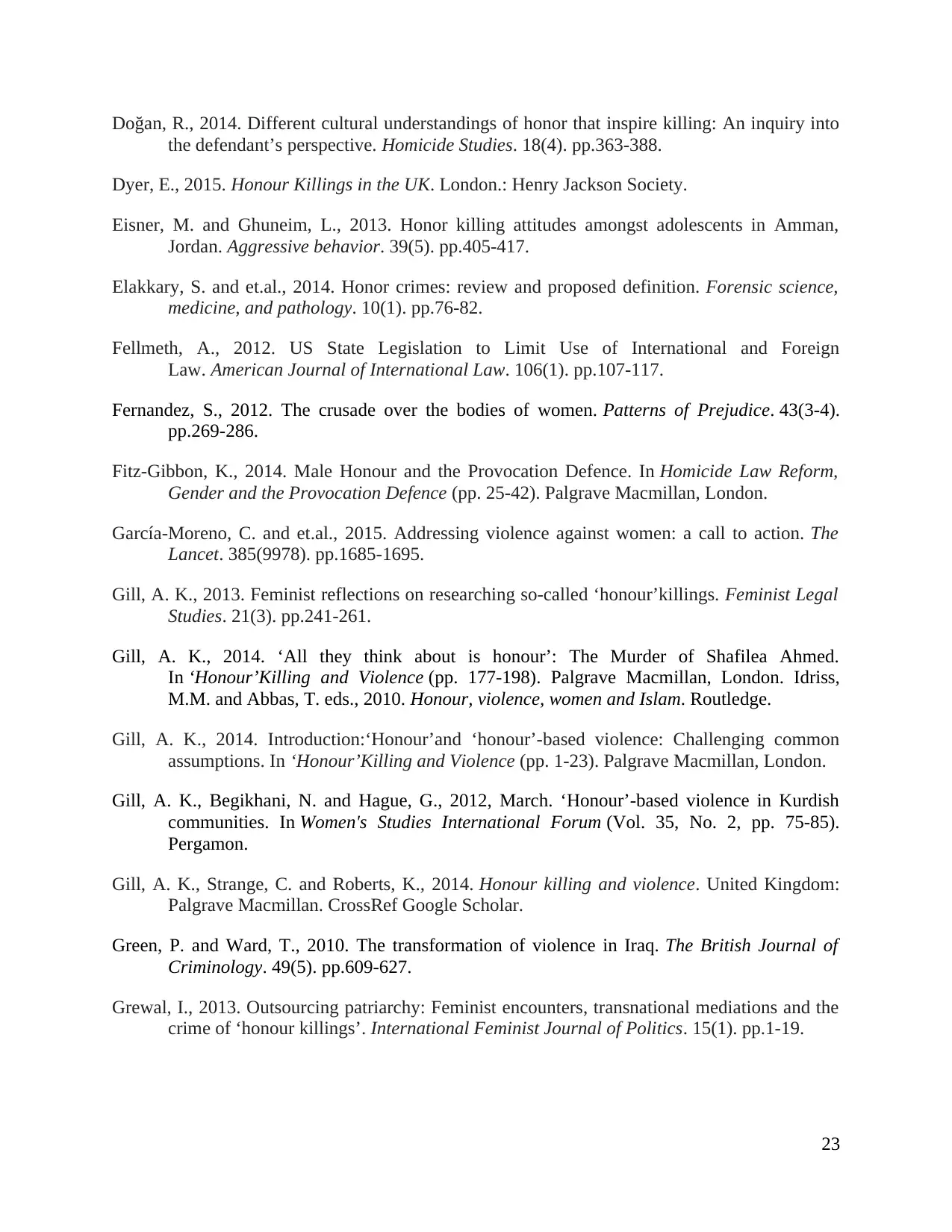
Doğan, R., 2014. Different cultural understandings of honor that inspire killing: An inquiry into
the defendant’s perspective. Homicide Studies. 18(4). pp.363-388.
Dyer, E., 2015. Honour Killings in the UK. London.: Henry Jackson Society.
Eisner, M. and Ghuneim, L., 2013. Honor killing attitudes amongst adolescents in Amman,
Jordan. Aggressive behavior. 39(5). pp.405-417.
Elakkary, S. and et.al., 2014. Honor crimes: review and proposed definition. Forensic science,
medicine, and pathology. 10(1). pp.76-82.
Fellmeth, A., 2012. US State Legislation to Limit Use of International and Foreign
Law. American Journal of International Law. 106(1). pp.107-117.
Fernandez, S., 2012. The crusade over the bodies of women. Patterns of Prejudice. 43(3-4).
pp.269-286.
Fitz-Gibbon, K., 2014. Male Honour and the Provocation Defence. In Homicide Law Reform,
Gender and the Provocation Defence (pp. 25-42). Palgrave Macmillan, London.
García-Moreno, C. and et.al., 2015. Addressing violence against women: a call to action. The
Lancet. 385(9978). pp.1685-1695.
Gill, A. K., 2013. Feminist reflections on researching so-called ‘honour’killings. Feminist Legal
Studies. 21(3). pp.241-261.
Gill, A. K., 2014. ‘All they think about is honour’: The Murder of Shafilea Ahmed.
In ‘Honour’Killing and Violence (pp. 177-198). Palgrave Macmillan, London. Idriss,
M.M. and Abbas, T. eds., 2010. Honour, violence, women and Islam. Routledge.
Gill, A. K., 2014. Introduction:‘Honour’and ‘honour’-based violence: Challenging common
assumptions. In ‘Honour’Killing and Violence (pp. 1-23). Palgrave Macmillan, London.
Gill, A. K., Begikhani, N. and Hague, G., 2012, March. ‘Honour’-based violence in Kurdish
communities. In Women's Studies International Forum (Vol. 35, No. 2, pp. 75-85).
Pergamon.
Gill, A. K., Strange, C. and Roberts, K., 2014. Honour killing and violence. United Kingdom:
Palgrave Macmillan. CrossRef Google Scholar.
Green, P. and Ward, T., 2010. The transformation of violence in Iraq. The British Journal of
Criminology. 49(5). pp.609-627.
Grewal, I., 2013. Outsourcing patriarchy: Feminist encounters, transnational mediations and the
crime of ‘honour killings’. International Feminist Journal of Politics. 15(1). pp.1-19.
23
the defendant’s perspective. Homicide Studies. 18(4). pp.363-388.
Dyer, E., 2015. Honour Killings in the UK. London.: Henry Jackson Society.
Eisner, M. and Ghuneim, L., 2013. Honor killing attitudes amongst adolescents in Amman,
Jordan. Aggressive behavior. 39(5). pp.405-417.
Elakkary, S. and et.al., 2014. Honor crimes: review and proposed definition. Forensic science,
medicine, and pathology. 10(1). pp.76-82.
Fellmeth, A., 2012. US State Legislation to Limit Use of International and Foreign
Law. American Journal of International Law. 106(1). pp.107-117.
Fernandez, S., 2012. The crusade over the bodies of women. Patterns of Prejudice. 43(3-4).
pp.269-286.
Fitz-Gibbon, K., 2014. Male Honour and the Provocation Defence. In Homicide Law Reform,
Gender and the Provocation Defence (pp. 25-42). Palgrave Macmillan, London.
García-Moreno, C. and et.al., 2015. Addressing violence against women: a call to action. The
Lancet. 385(9978). pp.1685-1695.
Gill, A. K., 2013. Feminist reflections on researching so-called ‘honour’killings. Feminist Legal
Studies. 21(3). pp.241-261.
Gill, A. K., 2014. ‘All they think about is honour’: The Murder of Shafilea Ahmed.
In ‘Honour’Killing and Violence (pp. 177-198). Palgrave Macmillan, London. Idriss,
M.M. and Abbas, T. eds., 2010. Honour, violence, women and Islam. Routledge.
Gill, A. K., 2014. Introduction:‘Honour’and ‘honour’-based violence: Challenging common
assumptions. In ‘Honour’Killing and Violence (pp. 1-23). Palgrave Macmillan, London.
Gill, A. K., Begikhani, N. and Hague, G., 2012, March. ‘Honour’-based violence in Kurdish
communities. In Women's Studies International Forum (Vol. 35, No. 2, pp. 75-85).
Pergamon.
Gill, A. K., Strange, C. and Roberts, K., 2014. Honour killing and violence. United Kingdom:
Palgrave Macmillan. CrossRef Google Scholar.
Green, P. and Ward, T., 2010. The transformation of violence in Iraq. The British Journal of
Criminology. 49(5). pp.609-627.
Grewal, I., 2013. Outsourcing patriarchy: Feminist encounters, transnational mediations and the
crime of ‘honour killings’. International Feminist Journal of Politics. 15(1). pp.1-19.
23
Paraphrase This Document
Need a fresh take? Get an instant paraphrase of this document with our AI Paraphraser
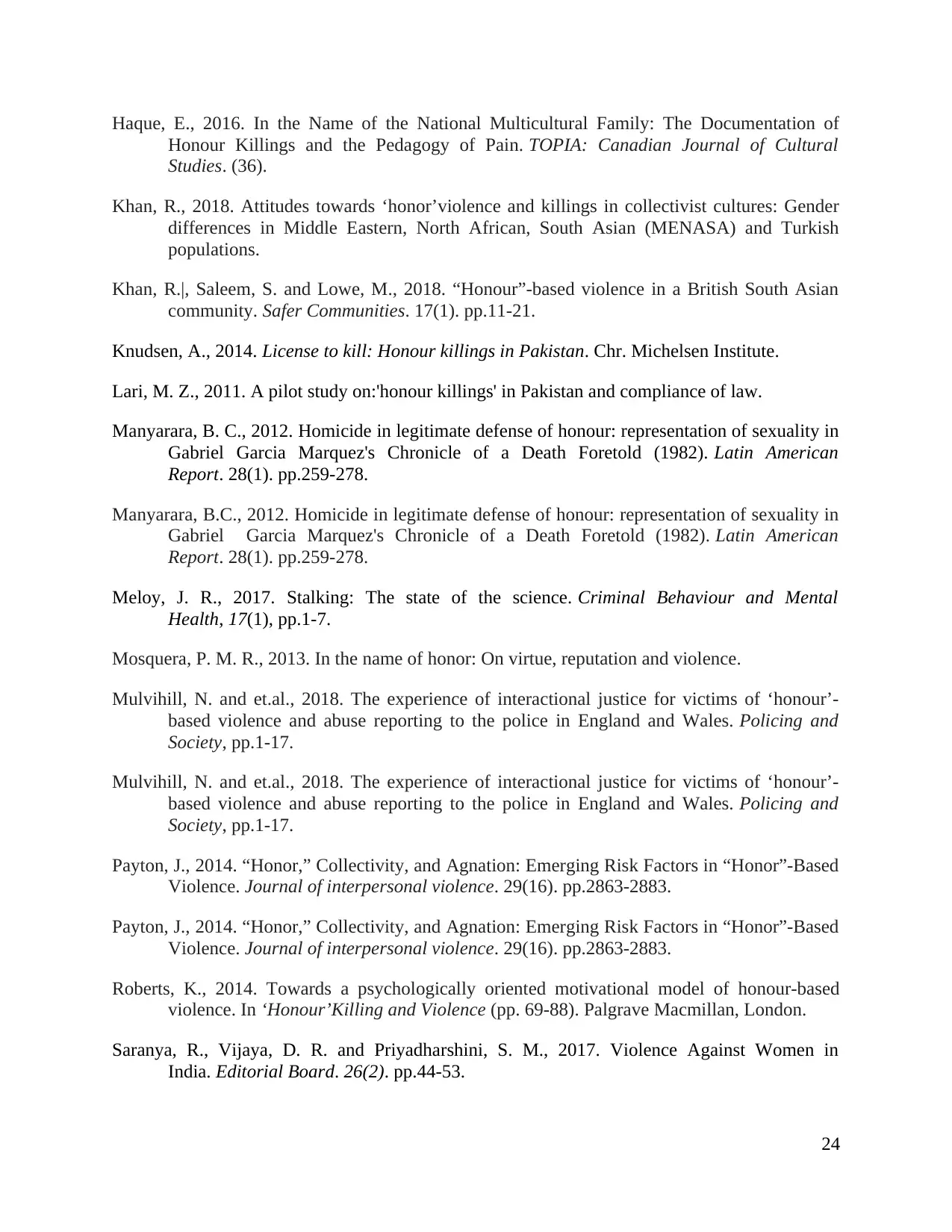
Haque, E., 2016. In the Name of the National Multicultural Family: The Documentation of
Honour Killings and the Pedagogy of Pain. TOPIA: Canadian Journal of Cultural
Studies. (36).
Khan, R., 2018. Attitudes towards ‘honor’violence and killings in collectivist cultures: Gender
differences in Middle Eastern, North African, South Asian (MENASA) and Turkish
populations.
Khan, R.|, Saleem, S. and Lowe, M., 2018. “Honour”-based violence in a British South Asian
community. Safer Communities. 17(1). pp.11-21.
Knudsen, A., 2014. License to kill: Honour killings in Pakistan. Chr. Michelsen Institute.
Lari, M. Z., 2011. A pilot study on:'honour killings' in Pakistan and compliance of law.
Manyarara, B. C., 2012. Homicide in legitimate defense of honour: representation of sexuality in
Gabriel Garcia Marquez's Chronicle of a Death Foretold (1982). Latin American
Report. 28(1). pp.259-278.
Manyarara, B.C., 2012. Homicide in legitimate defense of honour: representation of sexuality in
Gabriel Garcia Marquez's Chronicle of a Death Foretold (1982). Latin American
Report. 28(1). pp.259-278.
Meloy, J. R., 2017. Stalking: The state of the science. Criminal Behaviour and Mental
Health, 17(1), pp.1-7.
Mosquera, P. M. R., 2013. In the name of honor: On virtue, reputation and violence.
Mulvihill, N. and et.al., 2018. The experience of interactional justice for victims of ‘honour’-
based violence and abuse reporting to the police in England and Wales. Policing and
Society, pp.1-17.
Mulvihill, N. and et.al., 2018. The experience of interactional justice for victims of ‘honour’-
based violence and abuse reporting to the police in England and Wales. Policing and
Society, pp.1-17.
Payton, J., 2014. “Honor,” Collectivity, and Agnation: Emerging Risk Factors in “Honor”-Based
Violence. Journal of interpersonal violence. 29(16). pp.2863-2883.
Payton, J., 2014. “Honor,” Collectivity, and Agnation: Emerging Risk Factors in “Honor”-Based
Violence. Journal of interpersonal violence. 29(16). pp.2863-2883.
Roberts, K., 2014. Towards a psychologically oriented motivational model of honour-based
violence. In ‘Honour’Killing and Violence (pp. 69-88). Palgrave Macmillan, London.
Saranya, R., Vijaya, D. R. and Priyadharshini, S. M., 2017. Violence Against Women in
India. Editorial Board. 26(2). pp.44-53.
24
Honour Killings and the Pedagogy of Pain. TOPIA: Canadian Journal of Cultural
Studies. (36).
Khan, R., 2018. Attitudes towards ‘honor’violence and killings in collectivist cultures: Gender
differences in Middle Eastern, North African, South Asian (MENASA) and Turkish
populations.
Khan, R.|, Saleem, S. and Lowe, M., 2018. “Honour”-based violence in a British South Asian
community. Safer Communities. 17(1). pp.11-21.
Knudsen, A., 2014. License to kill: Honour killings in Pakistan. Chr. Michelsen Institute.
Lari, M. Z., 2011. A pilot study on:'honour killings' in Pakistan and compliance of law.
Manyarara, B. C., 2012. Homicide in legitimate defense of honour: representation of sexuality in
Gabriel Garcia Marquez's Chronicle of a Death Foretold (1982). Latin American
Report. 28(1). pp.259-278.
Manyarara, B.C., 2012. Homicide in legitimate defense of honour: representation of sexuality in
Gabriel Garcia Marquez's Chronicle of a Death Foretold (1982). Latin American
Report. 28(1). pp.259-278.
Meloy, J. R., 2017. Stalking: The state of the science. Criminal Behaviour and Mental
Health, 17(1), pp.1-7.
Mosquera, P. M. R., 2013. In the name of honor: On virtue, reputation and violence.
Mulvihill, N. and et.al., 2018. The experience of interactional justice for victims of ‘honour’-
based violence and abuse reporting to the police in England and Wales. Policing and
Society, pp.1-17.
Mulvihill, N. and et.al., 2018. The experience of interactional justice for victims of ‘honour’-
based violence and abuse reporting to the police in England and Wales. Policing and
Society, pp.1-17.
Payton, J., 2014. “Honor,” Collectivity, and Agnation: Emerging Risk Factors in “Honor”-Based
Violence. Journal of interpersonal violence. 29(16). pp.2863-2883.
Payton, J., 2014. “Honor,” Collectivity, and Agnation: Emerging Risk Factors in “Honor”-Based
Violence. Journal of interpersonal violence. 29(16). pp.2863-2883.
Roberts, K., 2014. Towards a psychologically oriented motivational model of honour-based
violence. In ‘Honour’Killing and Violence (pp. 69-88). Palgrave Macmillan, London.
Saranya, R., Vijaya, D. R. and Priyadharshini, S. M., 2017. Violence Against Women in
India. Editorial Board. 26(2). pp.44-53.
24

Shah Kakakhel, N. A., 2014. Honour Killings: Islamic and Human Rights Perspectives. N. Ir.
Legal Q.. 55. p.78.
Tekin, D., 2012. Victims of Law: The Efficiency of Turkish Penal System on Honour Killings.
Thapar-Björkert, S., 2014. ‘If there were no khaps […] everything will go haywire […] young
boys and girls will start marrying into the same gotra’: Understanding Khap-Directed
‘Honour Killings’ in Northern India. In ‘Honour’Killing and Violence (pp. 156-176).
Palgrave Macmillan, London.
Werbner, P., 2017. Veiled interventions in pure space: Honour, shame and embodied struggles
among Muslims in Britain and France. Theory, Culture & Society. 24(2). pp.161-186.
Wikstrom, E. and Ghazinour, M., 2013. Swedish experience of sheltered housing and conflicting
theories in use with special regards to honour related violence (HRV) Svenska
erfarenheter av insatsen. Social Work in Europe: Race and Ethnic Relations, p.112.
Online
'Honour crime': 11,000 UK cases recorded in five years. 2015. [Online]. Available through: <
http://www.bbc.com/news/uk-33424644>.
Honor killing. 2018. [Online]. Available through: < https://www.britannica.com/topic/honor-
killing >.
What Are “Honor Killings”, And How Can We Make Them Stop?. 2018. [Online]. Available
through < https://womenthrive.org/what-are-honor-killings-and-how-can-we-make-them-
stop/ >
25
Legal Q.. 55. p.78.
Tekin, D., 2012. Victims of Law: The Efficiency of Turkish Penal System on Honour Killings.
Thapar-Björkert, S., 2014. ‘If there were no khaps […] everything will go haywire […] young
boys and girls will start marrying into the same gotra’: Understanding Khap-Directed
‘Honour Killings’ in Northern India. In ‘Honour’Killing and Violence (pp. 156-176).
Palgrave Macmillan, London.
Werbner, P., 2017. Veiled interventions in pure space: Honour, shame and embodied struggles
among Muslims in Britain and France. Theory, Culture & Society. 24(2). pp.161-186.
Wikstrom, E. and Ghazinour, M., 2013. Swedish experience of sheltered housing and conflicting
theories in use with special regards to honour related violence (HRV) Svenska
erfarenheter av insatsen. Social Work in Europe: Race and Ethnic Relations, p.112.
Online
'Honour crime': 11,000 UK cases recorded in five years. 2015. [Online]. Available through: <
http://www.bbc.com/news/uk-33424644>.
Honor killing. 2018. [Online]. Available through: < https://www.britannica.com/topic/honor-
killing >.
What Are “Honor Killings”, And How Can We Make Them Stop?. 2018. [Online]. Available
through < https://womenthrive.org/what-are-honor-killings-and-how-can-we-make-them-
stop/ >
25
1 out of 30
Related Documents
Your All-in-One AI-Powered Toolkit for Academic Success.
+13062052269
info@desklib.com
Available 24*7 on WhatsApp / Email
![[object Object]](/_next/static/media/star-bottom.7253800d.svg)
Unlock your academic potential
© 2024 | Zucol Services PVT LTD | All rights reserved.





